











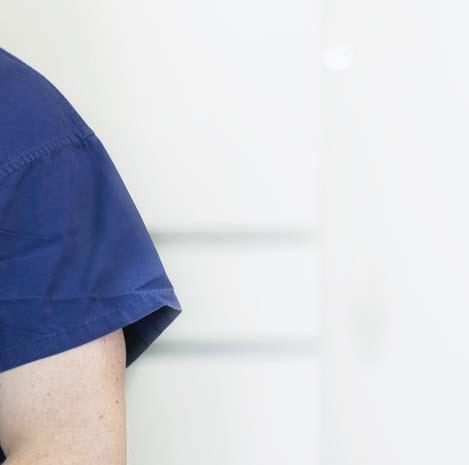


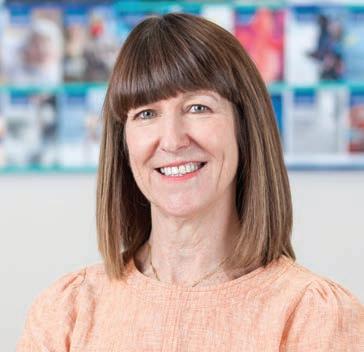
Critics labelled it a dysfunctional hospital that would continue to struggle. Yet high demand withstanding…the hospital has delivered.
The thing about anniversaries of key events in the health world is that it can make you feel old. But the softener is that it can show how doomsday predictions often come to nought.
This month, there were two of those moments for me – the 10-year anniversary of the opening of Fiona Stanley Hospital, and the 15-year mark since the introduction of folate fortification in flour.
When FSH started its progressive opening in October 2014, there were wheels falling off everywhere. As the then-health reporter on our city’s morning newspaper, it was fodder from heaven.
Doctors’ mobile phones couldn’t get a signal because there was a hiccup in the telecoms set up and there were concerns about infection breaches involving surgical instruments.
Add to that, the promise of a paperless hospital turned out to be not worth the paper it was written on!
Critics labelled it a dysfunctional hospital that would continue to struggle.
Yet high demand withstanding – which seems the fate of all public hospitals – the hospital has delivered...and not just babies.
Similarly, when a campaign to have flour fortified with folate – led by eminent child health researchers Professors Fiona Stanley and Carol Bower – gained traction in 2009, sections of the food industry said the world would stop revolving.
Today, no one thinks twice about the folate in their sandwich, but many children have been saved from devastating neural-tube birth defects.
Perhaps lessons could be learnt when it comes to doomsday predictions about the impact of vaping laws?
SYNDICATION AND REPRODUCTION Contributors should be aware the publisher asserts the right to syndicate material appearing in Medical Forum on the mforum.com.au website. Contributors who wish to reproduce any material as it appears in Medical Forum must contact the publisher for copyright permission.
DISCLAIMER Medical Forum is published by Medforum Pty Ltd (Publisher) as an independent publication for health professionals in Western Australia. Neither the Publisher nor its personnel are medical practitioners, and do not give medical advice, treatment, cures or diagnoses. Nothing in Medical Forum is intended to be medical advice or a substitute for consulting a medical practitioner. You should seek immediate medical attention if you believe you may be suffering from a medical condition. The support of all advertisers, sponsors and contributors is welcome. To the maximum extent permitted by law, neither the Publisher nor any of its personnel will have any liability for the information or advice contained in Medical Forum. The statements or opinions expressed in the magazine reflect the views of the authors and do not represent the opinions, views or policies of Medical Forum or the Publisher. Readers should independently verify information or advice. Publication of an advertisement or clinical column does not imply endorsement by the Publisher or its contributors for the promoted product, service or treatment.
Advertisers are responsible for ensuring that advertisements comply with Commonwealth, State and Territory laws. It is the responsibility of the advertiser to ensure that advertisements comply with the Competition and Consumer Act 2010 (Cth) as amended. All advertisements are accepted for publication on the condition that the advertiser indemnifies the Publisher and its personnel against all actions, suits, claims, loss or damages resulting from anything published on behalf of the advertiser.
EDITORIAL POLICY This publication protects and maintains its editorial independence from all sponsors or advertisers. Medical Forum has no professional involvement with advertisers other than as publisher of promotional material. Medical Forum cannot and does not endorse any products.




50 Film: Memoir of a snail
British Film Festival comp
Wine review: Sandalford – Dr Louis Papaelias

This month’s doctors dozen wine comes from none other than one WA’s most iconic names, Sandalford. Read Dr Louis Papaelias’ review on page 51, and then enter our competition and cross your fingers. To enter, use the QR code on this page or go to www.mforum.com.au and hit the competitions tab.
Five lucky readers and their guests are off to the Italian Film Festival this month and Medical Forum will have five double tickets to the British Film Festival to give away in next month’s magazine.
PUBLISHERS
Alice Miles – Director Fonda Grapsas – Director Tony Jones – Director tonyj@mforum.com.au
EDITORIAL TEAM
Editor
Cathy O'Leary 08 9203 5222 editor@mforum.com.au
Production Editor Jan Hallam 08 9203 5222 jan@mforum.com.au
Journalist
Eric Martin 08 9203 5222 eric@mforum.com.au
Clinical Editor
Dr Joe Kosterich 0417 998 697 joe@mforum.com.au
Graphic Design Ryan Minchin ryan@mforum.com.au
ADVERTISING
Advertising Manager
Bryan Pettit 0439 866 336 bryan@mforum.com.au
Classifieds Sales
Ross Bulman 0428 759 076 ross@mforum.com.au
Clinical Services Directory
Alice Miles 08 9203 5222 alice@mforum.com.au
CONTACT MEDICAL FORUM
Suite 3/8 Howlett Street, North Perth WA 6006 Phone: 08 9203 5222 Fax: 08 6154 6488 Email: info@mforum.com.au www.mforum.com.au
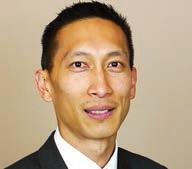




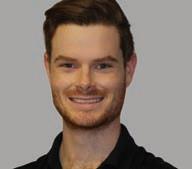






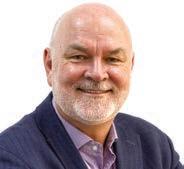


Volunteer ambulance officers in rural and remote areas of Australia are struggling with birth emergencies, which may have serious implications for patient safety, according to Perth research.
A study led by Edith Cowan University PhD candidate Michella Hill has found that many volunteer ambos (VAOs) feel anxious and uncomfortable attending unplanned out-of-hospital births and obstetric emergencies.
They had limited ability to manage complications due to a lack of education, training, exposure to births and a narrow scope of practice.
Ms Hill is developing virtual-reality training specifically designed to provide virtual exposure to a neonate born out of hospital.
Although unplanned out-of-hospital births are rare – less than one per cent of births – VAOs must be prepared to provide critical care in these high-risk situations.
“However, our research has shown that these volunteers are facing significant challenges when attending unplanned out-of-hospital births,” Ms Hill said. VAOs were concerned about the availability of backup from a registered paramedic, and the reliability of telecommunications in remote areas for online clinical
A research study led by Edith Cowan University to prevent injuries in police force recruits has secured more than $1.7 million in funding.
The project, funded by the National Health and Medical Research Council, WA Health and WA Police, is led by Dr Myles Murphy and involves incorporating a world-leading prevention program into recruit training.
Injuries to recruits are costly and take officers off the beat, and Dr Murphy said his research had already shown one in five police recruits around the world are injured during training.

advice and support, with ‘black holes’ creating a sense of isolation for those needing support from senior clinicians.
With funding from the WA Health Department and the Women and Infants Research Foundation, Ms Hill is developing immersive virtual reality training which could be a game-changer for rural and remote clinicians who lack access to in-person training.
The NEONATE in VR simulation program (Novel Educational Overview of the Neonatal Apgar and Treatment Experience in Virtual Reality) is designed to provide virtual exposure to a neonate born out of hospital.
The training helps refresh essential skills in assessing and managing newborns, including the one-minute Apgar score taken after birth. It is designed to strengthen basic knowledge, helping users understand what is normal, and not, for neonates.
on the sidelines, they aren’t able to complete their training and graduate and they are not out on the beat,” Dr Murphy said.
The move to allow 60-day prescriptions of more than 70 asthma medications has divided asthma expert groups.

Asthma Australia welcomed the addition of asthma medications to the 60-day Pharmaceutical Benefits Scheme prescriptions list from September 1, arguing it might help many of Australia’s almost 2.8 million people with asthma to save time and money and to better manage their condition.
medications on the 60-day list, saying that while it supported cheaper medicines for consumers, that needed to be balanced with the necessity for vigilance around medication expiry and wastage.
Primary healthcare professionals will now have access to free online education packages to upskill on essential respiratory topics of breathlessness, COPD and asthma.
The project, funded by the Australian Government, is delivered by the Lung Learning Partnership of the Lung Foundation Australia, the Thoracic Society of Australia and New Zealand and Asthma Australia.
Based on the number of days lost to injury during training, it is estimated that more than $500,000 per year is spent paying police recruits who are unable to train.
“Because the reality is the more time police are injured and sitting
It could also mean less frequent visits to the pharmacy and fewer GP appointments each year for repeat scripts.
But National Asthma Council Australia issued a caution regarding the inclusion of the asthma
Lung Foundation Australia CEO Mark Brooke said the new Quality Use of Medicines in Chronic Airways Disease (QUAD) healthcare professional education program would be available through

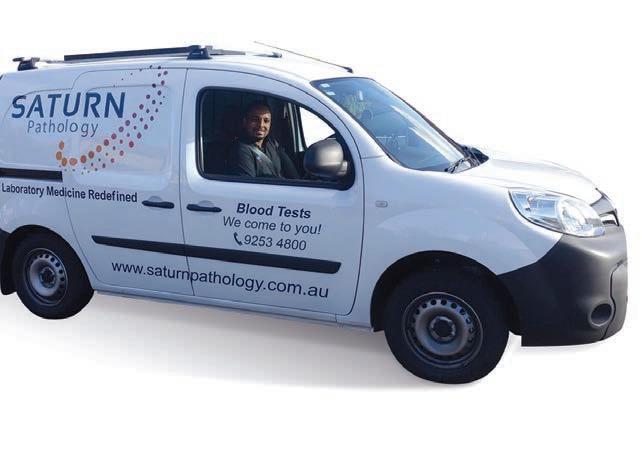


The former Telethon Kids Institute has a new name – The Kids Research Institute Australia, led by Prof Jonathan Carapetis. And Telethon Speech and Hearing has rebranded as TSH (Teach, Speak, Hear).

Fiona Stanley Hospital, named after one of WA’s iconic child health researchers, opened 10 years ago this month, becoming the biggest building project ever undertaken for the State Government.
Last month marked the 15th anniversary of the WA-led health campaign which resulted in the fortification of flour with folate to prevent birth defects.

Associate Professor Rishi Kotecha, a consultant paediatric oncologist and co-head of Leukaemia Translational Research at The Kids, is Cancer Council WA’s 2024 Cancer Researcher of the Year.
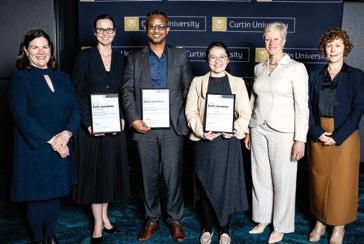
Research team ChemoDX team has won the Health Sciences Award at the Curtinnovation Awards for its test which can predict a patient’s response to platinum-based chemotherapy before treatment begins.
continued from Page 4
respiratory education and training platform, the Lung Learning Hub.
“QUAD’s education packages will be a game changer for primary care practitioners, giving quick access to the latest information based on best practice and evidence-based guidelines,” Mr Brooke said.
The education modules are part of the Lung Learning Hub, available at www.lunglearninghub.com.au/ the-quad.
Cancer Council WA has released a new study showing its SunSmart program is saving money as well as lives.
Published in Health Promotion International, the research confirms the SunSmart program is expected to prevent 300,0000 skin cancers, save 1000 lives and return $8.70 to the public purse for every dollar spent over the next 20 years.
The council’s Cancer Prevention and Research Director, Melissa
Ledger, said it was reassuring after years of running skin cancer prevention programs in WA to be able to measure the size of the benefit.
“For the WA Government, the estimated return on investment is $8.70 gained for every $1 invested. This equates to benefits of more than $166 million over 20 years.
“The results also make the case for increased and ongoing investment in a skin cancer prevention strategy to ensure skin cancer prevention is given the priority it deserves.”
Lead author Professor Louisa Collins said given the very high cost of therapies for advanced stage melanoma, around $100,000 per patient, preventing a preventable cancer to begin with was critical for our health system.
“Skin cancer is the most common and expensive to treat of all cancers to our health system,” Prof Collins said. “With increasing numbers of skin cancer, the healthcare costs of treating and managing skin cancers are expected to rise quickly.”
The world's largest clinical trial for phantom limb pain will investigate the effectiveness of two drugfree treatments that could provide pain relief.
NeuRA (Neuroscience Research Australia) is recruiting for TITAN, which is looking at treatments for the condition which baffles clinicians and affects up to 80% of people who have undergone limb amputation or had a spinal cord injury.
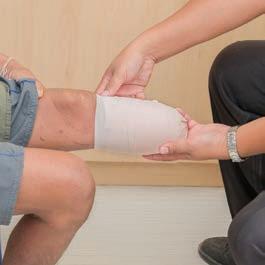
Phantom limb pain is sensation in a body part that is no longer present. This may include feeling that the ‘phantom’ limb is in a specific position or shape, is moving, is warm or cold, is itching, tingling or there is an electric sensation.
At its worst, the condition can cause unbearable symptoms, including intense burning, shooting, stabbing, crushing, and electric shock type sensations that can disrupt sleep and lead to depression and a loss of quality of life.
Senior research scientist and Director of the Centre for Pain Impact, Professor James McAuley, said there were currently no proven treatments that provide meaningful pain relief for people with phantom limb pain.
“This is a randomised clinical trial funded by the Commonwealth Government with the aim of reducing pain and improving function. Both treatments we are investigating are drug-free and aim to change how the brain processes pain signals coming from body.
“The first is a progressive rehabilitation program using techniques such as mirror therapy, while the second uses low frequency non-invasive neuromodulation.”
The randomised clinical trial is a large-scale, Australia-wide initiative that will be conducted online by physiotherapists, ensuring it is widely accessible.
By Cathy O’Leary

Surgeons need to provide more timely and detailed surgical case forms to the State’s compulsory mortality audit, a new report has warned.
The Western Australian Audit of Surgical Mortality, established as a voluntary review in 2002, is a peer-reviewed investigation of the care associated with surgery-related deaths to improve patient safety and quality of care.
The review includes patients who, for whatever reason, did not end up having surgery.
It is funded by the WA Health Department and has protection under federal legislation.
Participation in the audit became a mandatory requirement of the Royal Australasian College of Surgeons in 2010.
Overall, its audit of almost 2900 surgery-related deaths from 20192023 identified 30 adverse events which caused the death of a patient – nine of which were considered definitely preventable.
In 2022 and 2023 – subject to further review – there were no adverse events that were deemed to be definitely preventable, while five adverse events causing the death of the patient were viewed as being probably preventable.
Commenting on the audit, its clinical director and surgeon Dr James Aitken said there were significant changes that would have profound implications for RACS, the
Australian and New Zealand Audit of Surgical Mortality (ANZASM) and individual surgeons.
“Exactly when and where these changes land remains to be determined. It is very possible that in future years, 2024 will be seen as an inflection point in the Australian surgical safety and quality environment,” he wrote in his report.
The changes are linked to the setting up of continuing professional development homes including RACS, with a shift in the reporting of compliance from individual surgeons to the college, and the revised version of the Australian Commission on Safety and Quality in Health Care framework for Australian clinical quality registries (CQRs).
“If there is a single, unifying theme in these developments, it is the requirement of the jurisdictions for more complete case ascertainment, associated with more timely collecting and reporting of safety and quality data,” Dr Aitken said.
“The expectation is that there will be near real-time data collection, with longitudinal analysis being returned within three months, and in high-risk settings perhaps more frequently. Annual reports will no longer be adequate or acceptable.”
Dr Aitken said surgeons needed to complete and return their ANZASM surgical case forms (SCFs) within two months, and hospitals needed to promptly provide medical records when requested for a second-line assessment, or SLA.
“It is surgeons who undertake the SLAs…these are often not returned for many months and that will not satisfy the requirement of timely review,” he writes.
“The work for both the first and second-line assessors would be greatly reduced if surgeons provided more detail in the SCFs. This should be considered a professional responsibility in terms of safety and quality and a professional courtesy to consultant colleagues, the assessors.
“WAASM already returns poorly completed SCFs and in order to further reduce the burden on its assessors, may need to adopt a more robust position.”
General surgeons will, in addition, need to respond to the likely development of clinical care standards for emergency laparotomy, one of the two common surgical emergencies (along with hip fracture) which have a high mortality.
Turning to the 2024 report itself, Dr Aitken said the increase in deaths first noted in 2021 had continued, and in the absence of any other explanation, it was likely to be secondary to COVID-19.
“Whether it is a direct effect of active COVID-19, or a legacy effect of previous infection, as suggested in last year’s WAASM report, is unknown,” he said.

With an ageing population and a sharp rise in chronic conditions affecting almost half of Australians, the public health sector faces numerous challenges. The outcome of the election and subsequent policies will profoundly impact the sector's future and the well-being of Australians.
The first step is to understand what an election cycle is and how it influences policy changes. An election cycle is the period between two consecutive elections, typically spanning three to four years. It involves various phases, including campaigning, voting, and the subsequent implementation of policies by the elected government.
Health is one of the single largest government expenses and is a critical sector where the Commonwealth and States often engage in cost-shifting or seek creative ways to secure recurrent or uncapped funding.
Additionally, election cycles influence Commonwealth-State funding agreements that determine costsharing. Combined with factors like GST allocation, these agreements allow for mapping impacts over a cycle. Mid-Year Economic and Fiscal Outlook, the budget, elections, and funding agreements all present recurring opportunities for engagement, enabling health organisations to strategically plan their advocacy efforts.
Health services and organisations should align their strategies, workplans and activities with these election cycle timelines. Recognising the lengthy process required for sustained funding and the political preference for opportunities that are
As we head into an election year, it is a critical time for health organisations and services to strategically advocate for their priorities, argues political strategist Angus Crowther
more favourable for positive media is crucial.
It's essential to balance capital and operational requests while ensuring that projects are ready and aligned with both government and opposition agendas. This strategic alignment can significantly increase the likelihood of securing support and funding for key health initiatives. As the electoral cycle progresses, there are three main opportunities for health organisations to engage in advocacy and secure funding.
The first is during the budget cycle, which typically starts around July each year and continues through to May of the following year. An expenditure review committee or similar body will decide on priorities, based on government revenue and the electoral and economic situation.
The second is the MYEFO. This update, often referred to as a minibudget, occurs midway through the fiscal year and provides a critical opportunity for organisations to promote, advocate for, or secure funding.
The third opportunity arises from significant events or circumstances outside of the regular budget and MYEFO cycles. These events, such as the COVID -19 pandemic, can prompt government action and create opportunities for organisations that engage in effective advocacy.
In the health sector, interactions with governmental bodies and individuals differ significantly compared to other industries. It's a heavily government-funded sector with complex stakeholders and a pronounced vertical fiscal imbalance between the Commonwealth and
States. This complexity requires longer lead times, nuanced strategies, and thorough stakeholder mapping to effectively navigate advocacy and policy implementation processes.
For those looking to drive meaningful change in the health industry during an election year, here is some advice:
• plan and map funding agreements, political cycles, MYEFO, and budgets comprehensively
• look for creative ways to enlist support from States to advocate to the Commonwealth, or vice versa
• think in longer timeframes and cycles when strategising
• map the impact of initiatives to electorates
• don’t spend entire meetings discussing problems and your organisation; instead, propose solutions, generate ideas, and actively listen to stakeholders
• don’t embarrass the government into action when finances are tight
• don’t use the crossbench to antagonise the government; it can be counterproductive.
In a sector heavily reliant on government funding, leveraging the strategic opportunities of the election cycle is crucial for health organisations and services. A focused strategy and careful planning are the keys to securing vital election commitments and advancing sector priorities effectively.
ED: Angus Crowther is co-founder and executive director of Tanck, which specialises in engagement with government.
As Medical Forum expands its news service adding a weekly digital newsletter, a fortnightly clinical update and an evolving podcast series to our flagship magazine, so too has the demands of our business.
This month we welcome Alice Miles, who joins fellow directors Fonda Grapsas and Tony Jones in leading Medical Forum into this exciting new phase. Alice, who will be wellknown in medical circles in previous marketing roles, will also be the face of our Clinical Services Directory.
Alongside is our new advertising manager Bryan Pettit, who has extensive experience in sales across a wide range of WA media. He will be the go-to person for all display and digital advertising.
To get in touch with Alice or Bryan or anyone else on the MF team, check the details on the publishing panel on page 3.
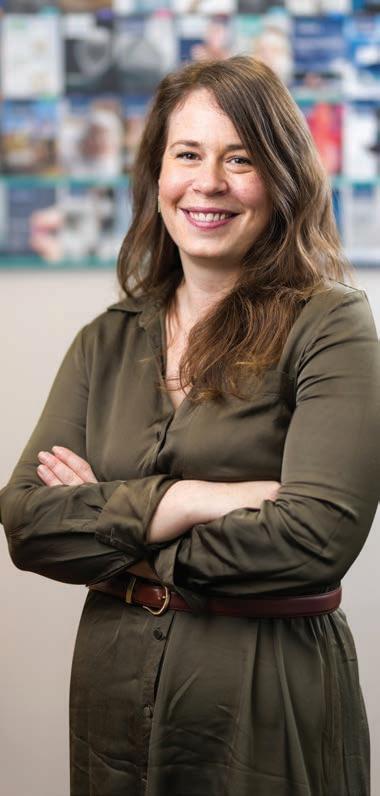

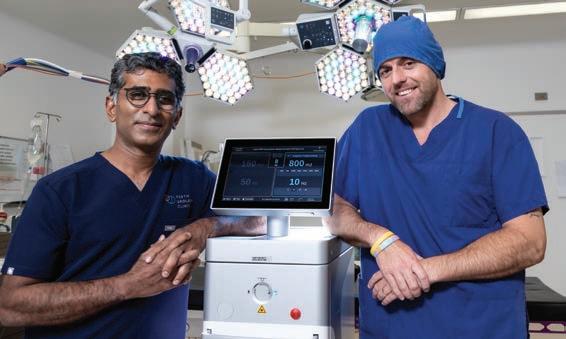
Australia’s first pulsed thulium crystal laser has helped more than 200 WA urology patients in its first year of operation.
Since acquiring the laser, surgeons at St John of God Murdoch Hospital have helped 233 patients with kidney stones, enlarged prostates and other urological conditions spend fewer minutes under anaesthesia, and be on the road to recovery sooner.
SJG Murdoch was the first health care facility in Australia to adopt THULIO, a pulsed thulium highpower laser by Dornier MedTech when it was installed in August last year.
The hospital’s head of urology, Dr Jeff Thavaseelan, said the benefits of the thulium crystal laser technique was two-fold, improving the theatre efficiency and reducing the procedural time under anaesthesia for patients.
Globally, THULIO is becoming the laser system of choice for stones and benign prostatic hyperplasia, with installations growing rapidly since its launch in late 2022.
The laser provides enhanced capabilities for urology stone treatments, and can reduce lithotripsy and tissue ablation procedure times, while minimising the risk of bleeding through improved coagulation and causing less damage to surrounding tissue.
In a guest column published in our September magazine – mRNA sets sights on influenza vax by Vinod Balasubramaniam – it stated that 99% of deaths in children under five years of age in developing countries are due to influenza-related infections, according to the World Health Organization.
In fact, the WHO research states that 99% of deaths in children under 5 years of age with influenza-related lower respiratory tract infections are in developing countries.

In what is said to be an Australian-first, WA’s biggest health insurer will ask hospital patients to rate their clinical care including whether they are happy with the outcome.
By Cathy O’Leary
Surveys of hospital patients are hardly new, with people often quizzed about their stay and whether they liked the food and felt looked after.
But in what is thought to be the first move of its kind in Australia, HBF is set to launch a detailed data collection system which will see patients asked about their clinical experience – and importantly if the outcome was what they expected.
This will see patients give feedback about their doctor including rating their satisfaction with their treatment or surgery – details of which will be fed back to hospitals and doctors themselves.
It is based on an international model which has been used in some jurisdictions for several years. It has two parts – PREMS or patient reported experience measures –and PROMS or patient reported outcome measures.
According to HBF, the concept has been used by some health funds and hospitals in Australia but often in a limited or in-house capacity that does not allow any meaningful comparison or analysis of trends.
In coming months, the insurer will start to target private hospital admissions as well as those admitted to public hospitals as private patients among its one million WA members and expects to send out up to 800,000 surveys each year.
HBF Group Executive Insurance and Health Services, Dr Daniel Heredia , said the concept had been around for some time, but not adopted in any significant way in Australia.
“It’s not about the wifi or the food.”
– HBF’s Dr Daniel Heredia
“This is not about the wifi or the food – it’s about the elements of the experience that actually lead to improvements in clinical care.”
The PREMS/PROMS model comes under the umbrella of value-based care, and HBF says it will ultimately help to pinpoint low-value care – a concept established by Harvard Business School Professors Michael Porter and Elizabeth Teisberg many years ago.

It led to the development 12 years ago of the International Consortium for Health Outcomes Measurement, which now includes more than 40 datasets of patient outcomes measuring 60% of diseases and conditions, including atrial fibrillation and diabetes.
“You’re really starting to track longitudinally – for that individual for that specific condition – what was their outcomes after two weeks, three months, 12 months.
“If they had a joint replacement, after 12 months are they able to sit or stand properly, are they able to jog or run, so it’s very diseasespecific and there is a significant evidence base behind these surveys, and they’re standardised and being used internationally.”
Dr Heredia said HBF was the only major health fund in Australia that he was aware of that would be running both PREMS and PROMS on this scale. Medibank ran PREMS across its clinicians, but not PROMS, and other health funds had dabbled in a very select way, perhaps with one disease.
“We will be the first major fund to run it across every one of our patient admissions in this State – so it’s significant numbers – between 500,000 and 800,000 surveys going out every year,” Dr Heredia said.
“We are a bit behind here, but it’s not straight forward and it’s a big piece of work, and you have to commit to it because it takes an extended period of time before there are enough data points to use it meaningfully,” he told Medical Forum
“The concept is not dissimilar to how, when you access a service, you might get a ‘please rate the call’ or your experience – so that is the essence of it, but on steroids.
“Even with experience surveys, they have traditionally asked things like ‘were you happy’ and ‘how was your hospital stay’, but this goes much more into the clinical care. So we’re asking things like ‘when you were in pain, was this addressed’ and ‘were you able to access appropriate information about the procedure’ rather than was the wifi fast enough.
“It’s the things that are relevant to clinical care and that’s why when you look at some of the statistics, if you have a 1% improvement in your PREMs or experience, there’s a lower rate of readmission.
HBF argues that patients are the best judges of the impact of their illness and treatments, but currently there are limited ways to capture their feedback across the whole cycle of their care.
The backdrop for the new program is the escalating healthcare spend, which is not necessarily leading to improvements in clinical outcomes, with some studies suggesting that 30% of health expenditure is waste, duplication or of low value, and 10% of it results in harm or adverse events.
“It’s with the outcomes side of things that things get interesting because it’s very evidence-based and structured,” Dr Heredia said.
“There are 45 different data sets already made by this international consortium, which is a not-for -profit, dealing with the most common medical conditions –things like prostate cancer surgery, heart failure and osteoarthritis.
“There is a standardised set of questions that get asked in various frequencies, so it’s not necessarily one-off questionnaires, and depending on the disease, you might get three separate surveys that come out over a period of 12 months.
“Because those numbers are so big, we will be uniquely placed that within six, 12, 18 months we will start to have significant amounts of data that we can share back, initially with the hospitals, and over time with the doctors.
“We can also ultimately drill down to what was the difference depending on the operator – that’s how powerful the data is once you get the numbers there, but that takes a long time.
“The intent then is to share that directly with the surgeons. It’s not about us giving it to the membership, we want to share that information with the doctors and the hospitals to say ‘look this is how you’re performing against the broader peer group and do with that as you will.’
“But experience internationally shows that most people once they actually get the data, they’re motivated to do something with it.” He accepted there could be pushback from some doctors or health care operators, but said the campaign was not about trying to reduce benefit payments, stopping
continued on Page 13

Nerissa Ferrie Medico-legal adviser
Am I obliged to provide a treating doctor report?
Musculoskeletal injuries are high on the list of requests for treating doctor reports - which can come from a variety of sources including patients, their lawyers, insurers and employers.
Consent Format for the report
Unless compelled by law, consent should be obtained from the patient (or their parent/guardian) before any personal health information is released. It is recommended that consent is obtained prior to the report being prepared.
A medico-legal report will usually include:
• Your credentials, including professional address, qualifications, experience and position at the time you were involved in the patient’s care
• The requesting party’s name, the date of the request, the purpose of the report, and the date of the authority
• The patient’s name and date of birth
• Medical facts in chronological order: – presentation (history and symptoms) – examination findings – investigations – provisional diagnosis – treatment/management – current condition – prognosis
• Your response to any specific questions
• Your clinical opinion (where appropriate)
• Your signature and the date the report was completed.
If you have no independent recollection of your management of the patient, the information in the report will be based solely on what’s recorded in the medical records (e.g. ‘I have no independent recollection of my involvement in the patient’s care. According to the medical records…’). If the report refers to a colleague’s notes, this should also be clear (e.g. Dr Smith’s notes indicate…’).
Irrelevant information shouldn’t be included; but clinically relevant information must not be omitted. If the patient only consents to certain parts of the relevant information being released, then you should consider whether this is a withdrawal of consent and advise the requesting party that consent has been withdrawn. Gratuitous comments about third parties should also be avoided.
• Allocate time to review requests and prepare reports.
• Your practice may have clear policies around requests for reports, including a minimum timeframe for a report (e.g. 14 days), a schedule of fees, and a requirement for pre-payment prior to the release of the report.
• If you are unsure about fees, you can use your normal hourly rate. Statutory bodies may have a prescribed fee schedule which may be provided with the direction or order.
• Before commencing work on a report, consider the amount of work involved and provide a cost estimate so the fee can be agreed before you start drafting the report.
• You should decline to respond to questions which are outside of your scope of practice or your area of expertise.
• Refer to the medical records, and don’t rely on your memory, or information provided by the requesting party.
• Address the report to the requesting party, and not “to whom it may concern”. If you don’t have a specific addressee, you can address the report to the patient.
• your signature and the date the report was completed.
If you have no independent recollection of your management of the patient, the information in the report will be based solely on what’s recorded in the medical records and if the report refers to a colleague’s notes, this should also be clear. Irrelevant information shouldn’t be included; but clinically relevant information must not be omitted. If the patient only consents to certain parts of the relevant information being released, then you should consider whether this is a withdrawal of consent and advise the requesting party that consent has been withdrawn. Gratuitous comments about third parties should also be avoided.
Professional Obligations
The Medical Board of Australia provides clear expectations for treating doctors who are providing medico-legal reports under section 10.9 of Good medical practice: a code of conduct for doctors in Australia.1
Legal obligations Tips and traps
It is important to be aware that any opinions expressed in a medicolegal report may be publicly tested and challenged in court. The weight given to the opinion will generally depend on the expertise and experience of the author.
• Ensure that you are legally compelled or have the patient’s permission to provide a report.
• Prepare your report within a reasonable time frame – if necessary, discuss this with the requesting party.
• Always refer to your medical records when preparing the report.
• Remember that you may be cross-examined on your report – only write what you would be prepared to give evidence to in court.
• Do not alter your report at the request of your patient or a third party – if you receive additional information, or you need to correct an error, provide a supplementary report.
• Explain medical terms and concepts in plain English and avoid using legal terminology.
• Differentiate fact(s) from opinion(s) and avoid using emotive language.
• Do not act as an advocate for your patient or be tempted to deliberately omit any relevant information.
If the request is unclear, or you have any specific concerns about the request or the report, contact our Medico-legal Advisory Services team for advice.
1 https://www.medicalboard.gov.au/Codes-Guidelines-Policies/Code-of-conduct.aspx
continued from Page 11
patients having the care they need, or pitting patients against doctors.
“We should never be afraid of data, transparency and quality improvement. There is increasing acceptance, and it will come down to how we use this data, and we’re very clear it will be used to support improvements in care, and you can’t achieve that by just throwing data out there in the public domain.
“It’s more about giving it back to providers and supporting them, and we would love to partner with them, if they’re interested, as to why there is a variation, and what they can do as an individual or hospital to improve that.
“Some people will say ‘it’s none of your business, you should just pay the bills’, and there will anxiety about what we’ll do and what’s the end goal, but the intent is about quality improvement and not ways to reduce costs.”
But Dr Heredia said that if the outcome ended up being that certain procedures proved to be not as beneficial from a patient outcome point of view, that expenditure could be redirected to new treatments or used to reduce premiums.
The bottom line was to improve outcomes for patients and the performance of health care organisations.
While taking part in the surveys would be voluntary for patients, Dr Heredia said it was important to get high participation.
“Our system will know whenever our member has a procedure or is admitted to hospital. It will then look at their demographics such as age, where they live, and decide, based on historical experience, whether that patient is more likely to respond if they get an SMS or an email,” he said.
“They will be contacted saying you’ve just completed your admission, and we really want to hear from you, and that’s how they will receive their survey.
“We need them to respond, and, positively, the experience with some smaller health funds is that
40-50% of members respond, and that shows people really want to take part.
“They will be prewarned that we’ll be collecting data down the track, but we’ll need to educate them about this process.”
Over time, information would be shared with doctors. The insurer might also identify specific doctors who were high volume or significantly deviating.
“We would like to work with them and show them the data, because if they are an outlier we want to understand why – and there might be a good reason why they are,”
Dr Heredia said.
“Increasingly, with most colleges and CPD, there are requirements for doctors to review their practice and the outcomes, so hopefully this will help doctors. We can collect data for doctors, and they can do the reflective part.”
private, doing the same procedure. It would be amazing for the public system to come on board, where everyone is doing the same standardised procedures.”
So far, doctors’ groups and health care operators have been reluctant to be drawn on the merits or otherwise of the HBF initiative, which is due to rolled out in coming months. Some have informally told Medical Forum that the devil will be in the detail and how the data is used.
St John of God Health Care Group CEO Bryan Pyne said his organisation supported HBF’s commitment to improving patient outcomes through its value-based care initiative, using patientreported experience and outcome measures.

Dr Heredia said there was a finite pool of resources and the annual growth rate in terms of health care costs was far-outstripping the ability of anyone to support it. This was a pressing issue for all funders – Federal and State governments as well as insurers.
“Clinicians are often operating in isolation, particularly in the private system, and that makes it hard to know how they are compared with other people. And there is so much information out there, it makes it hard to stay on top of what’s the evidence-based practice and, most importantly, it’s about making sure the care provided is tailored to suit the person in front of you.
“That’s where the outcomes come in. it’s not about saying everyone who has osteoarthritis of the knee needs to have a joint replacement, it’s about saying what is important to this person, what is the outcome they want and how we best give those outcomes.
“I think this will also have a flow-on effect to the public system because many doctors work in public and
“As an organisation, we have a long-standing practice of capturing patient experiences and using this data along with patient co-design principles to drive service optimisation,” he said. “We welcome any initiative that seeks to further improve the quality of care and patient experiences.”
But Mr Pyne said it was crucial that patient feedback was contextualised within the complexity of healthcare delivery.
“We appreciate the opportunity for continued engagement with our healthcare provider peers and all health funders to ensure that the data collected is used constructively and supports meaningful improvements.
“Our shared goal is to improve patient outcomes while maintaining the trust and collaborative relationships between patients, clinicians, health professionals, providers and funders.”

Dr Shirley Bowen took over the role of Department of Health Director General five months ago. She shares with Medical Forum some of her visions for the sector and answers some key questions that her department faces in the coming years.
My passion for person-centred care has inspired and motivated me every day of my 30-plus years in medicine. Excellent and compassionate healthcare should be available to everyone.
I started my career in sexual health medicine at the peak of the HIV epidemic in Sydney. This led to me training as a physician focusing on infectious diseases.
Caring for those with HIV both in Australia and in Africa was very formative for me in terms of understanding cutting-edge medicine, shared and
MF: The role of Director General of Health has been described in the past as a ‘poisoned chalice’ because of the demands it entails. Have your first few months been challenging and in what ways?
SB: Every role comes with its challenges and certainly the role of Director General has many! However, I could not resist an opportunity to try and improve the health of our community and hopefully improve the experience of our staff.
The span of control of the role does make it both challenging and interesting. WA is diverse due to its geographical size and providing care to the rural and remote communities is an area of interest of mine. I am driven by a passion for excellent healthcare, and I love to solve big complex problems, so the role is a career goal despite its reputation!
This winter has presented some unusual challenges as it has been the ‘winter of older people’ needing care. It appears the ageing of the population has finally arrived, and all sectors need to adapt to ensure we help people to age gracefully and with excellent care.
MF: If you had to pick a few key areas of focus for you and the department, at the moment, what would they be?
SB: Access to care (emergency, surgery, outpatients), caring for our ageing population, growing and sustaining our workforce, renewing infrastructure and technology, digital transformation and ensuring the sustainability of our health system.
Additionally, there are some emerging areas where prevention is key including family and domestic violence, mental health and supporting our neurodiverse population.
The further rise of genomics and precision medicine will bring opportunities for more rapid diagnoses for patients and increase chances to tailor care.
I want to create the conditions to enable our health system to remain responsive and capable of meeting the growing demands of our diverse population.
I am also committed to our ambitious health and medical research agenda, positioning Western Australia at the forefront and bringing home
cooperative care with those affected and, sadly, a significant experience in palliative medicine. Once through those years, I became committed to public health and the many opportunities to prevent illness across the population.
Now five months into this role as Director General, I am taking a global view on how we can work together to achieve excellence in prevention and management of acute and chronic disease across the entire age spectrum.
I will share some statistics to put this into perspective. These won’t surprise medical practitioners, but they are a reminder of the scale of Western Australia.
WA Health proudly services all 2.5million square kilometres of our great State, the largest area in the world covered by a single health system. We are also the largest public sector agency, with a budget of almost $13 billion and a workforce of more than 57,000 people.
In one year, we have up to one million attendances at our emergency departments, perform more than 90,000 elective surgeries and deliver more than 30,000 babies.
Leading this system is a great privilege and a great responsibility, and I am extremely proud of the care that our dedicated health professionals provide.
our clinician researchers from overseas. I am also keen to see further progress in translational research initiatives, taking scientific discovery through to practical application, enhancing care for our patients.
MF: You have extensive experience in both the public and private health sectors, including a long association with SJOG Subiaco Hospital. How has that helped equip you for your current role?
SB: I have a unique perspective having worked in almost all sectors of health care. The private system focuses you on both the consumer and doctor experience and I think that has assisted me to understand what patients value in their admission.
Quite importantly, the current challenges for the private sector mean I understand their fiscal outlook and I hope to make working together easier in the future given their important contribution to healthcare in WA.
I also believe that my financial training with St John of God has equipped me to manage the WA Health budget responsibly. I always say that I am ‘financially diligent’, always a doctor and not an expert, but I will do my best to ensure we manage responsibly into the future.
Health is forever-changing – the advent and pace of new technologies and treatments is breathtaking. We stand on the brink of one of the great industrial revolutions of our time. The innovation and improvement that digital transformation can bring us is incredible, and in the end will support our medical workforce into a different but more precise and personal way of working.
We all want a healthier future for West Australians and now is the time to consider how we can embrace these new frontiers deftly and responsibly to deliver the best care for our patients.
There are some exciting opportunities – electronic medical records, wearable technology – which will help us work smarter and make things easier for our staff.
We also need to look at how we create opportunities for people to access healthcare closer to home.
With the scale of the work at hand, I have embarked on an organisational review of the Department of Health to better align its functions to deliver these important reforms with a keen eye on patient-centred care at the heart.
This is about how we best use the expertise and skills of our dedicated staff to further improve healthcare for the people of Western Australia.
Health is forever-changing – the advent and pace of new technologies and treatments is breath-taking. We stand on the brink of one of the great industrial revolutions of our time.
MF: Following on from that question, the Federal Government is currently doing a financial health check of Australia’s private hospital sector amid concerns about its viability and future. How important is the private hospital system in terms of supporting the public system – i.e. their symbiotic relationship?
SB: A sustainable WA health system is a priority. For our system to work, we need both public and private services running effectively. The private sector operates a large number of beds in Western Australia, and it is essential that those beds operate successfully.
A significant amount of elective surgical work is done by the private sector, while the public system clearly does both elective and a large amount of emergency surgery. With the volumes of surgery needed post the COVID pause, we
need to ensure that work that can be done in private is done in private so that others can access timely surgery in the public system.
The Federal Government review I hope will recommend some viability options for both the insured, the insurer and the hospital operators.
MF: WA public hospitals remain very busy, from their EDs to their wards. Are there still issues with good access to primary health care that are adding to the pressure on the public system? What can we do better?
SB: Health systems around the world are under pressure mostly due to the ageing of populations and the fact that if people live longer, inevitably you will see more chronic conditions including dementia. This is compounded by
continued on Page 17
Dr Stephanie Giandzi Recent fellow


continued from Page 15
a relative shortage of workforce in key areas, which does make digital support and transformation a burning platform.
Those medical shortages include primary care. Unfortunately, primary care is just like our hospitals: busier than ever. My ideal world would see more general practitioners and a different type of access to primary care. A world where everyone is triaged to the right type of care, closest and available.
I doubt that the Australian health system can flex this far but hopefully we can create more options for care to assist those living with chronic conditions in the community which mean they don’t have to come through the ED.
We are doing everything we can to address these challenges in the Western Australian context. Our major reforms underway include the State Health Operations Centre (SHOC) and its initiatives, the Patient Transport Coordination Hub, WA Virtual Emergency Department and System Flow Centre.
Through SHOC, we are working closely with our partner agencies with the shared goal of helping patients to get the right care in the right place at the right time. It is exciting to see this central coordination of patient ambulance and transfer access coming to fruition.
MF: There have been concerns in the past about families and parents feeling they are not always listened to when seeking out emergency care, with one resulting change being the setting up of the Aishwarya’s CARE Call process in all WA public hospitals. Has this helped bridge the gap between families and clinicians/ admin?
SB: Listening to patients and families is critically important and the introduction of Aishwarya’s CARE Call across emergency departments was a very important initiative and was introduced as a priority in 2021.
It has seen families with concerns call for assistance. However, it
With the scale of the work at hand, I have embarked on an organisational review of the Department of Health to better align its functions to deliver these important reforms with a keen eye on patient-centred care at the heart.
does not take the place of active listening. All our medical students are taught the importance of active listening and shared decision making and this education is key.
The Clinical Senate will consider the important topic of ‘listening’ at its meeting later this year. I look forward to hearing some more suggestions to hard-wire this important skill into our medical consultations.
MF: The AMA’s recent doctorsin-training surveys have again identified instances of bullying, harassment and discrimination experienced by junior doctors. How can hospitals do better, and how much of that behaviour is ingrained in medical practice?
SB: Supporting and developing our doctors in training (DiTs) is vital to the future of our health system. Hearing from our DiTs about their experiences is how we drive change.
Everyone deserves a workplace without harassment of any type. Medicine is a hierarchical career pathway and when I was a young doctor this type of thinking was well ingrained in our training. Everyone has a role in stopping bullying and harassment. Speak up and call it out when it occurs. That doesn’t need to be a shouting match but a calm and clear conversation with appropriate support.
Through the years, I have experienced most forms of discrimination in the workplace. I encourage DiTs to speak up and tell a colleague who can assist with seeking support and an intervention.
There were some encouraging signs in the most recent AMA survey.
It was reassuring to hear junior doctors feel safe coming to work – 81% reported they feel safety is always or often a priority at their workplace. This was a significant improvement from previously.
Our health services providers are hearing DiTs and supporting them in innovative ways including North Metropolitan Health Service’s Junior Doctors Manifesto and South Metropolitan Health Service’s Junior Doctor Support Unit which launched earlier this year.
When it comes to culture, I strongly believe that leaders should set the tone and demonstrate kindness and support so it flows through the organisation.
MF: What lessons have been learnt from the COVID pandemic experience in terms of systems needing to be nimble/flexible in responses?
SB: The pandemic showed that we can adapt very quickly to a changing health landscape. WA did something incredibly unique during COVID and that was to create the ‘cordon sanitaire’ around WA. Usually in public health, such acts are done to keep disease in but WA kept disease out.
I am not sure if the community realises that this was one of the great public health actions of our time and will be recorded very positively by history.
I also think the pandemic showed our isolation in the supply chain for many goods including antibiotics and medical products. We need to remedy this situation with local production to ensure we have a more resilient supply chain for the future.

Amid a widespread cost-of-living crisis, people diagnosed with coeliac disease are paying significantly more for basic staples. Could the introduction of doctorprescribed subsidies be the solution?
By Suzanne Harrison
Mealtimes at the home of Rupert Bell and his family involve two separate work areas for preparation as well as ensuring there is a separate section of the pantry and in the fridge.
The 58-year-old was diagnosed with coeliac disease only three years ago but has lived with debilitating pain and stomach issues since his 40s.
Consuming gluten at all – even the smallest amount via cross-contamination – can result in bloating, lethargy, nausea, pain, stomach cramps, among other problems.
“If there’s cross-contamination, I will get sick, so my food is prepared and cooked first,” he says. “It is embarrassing to go to other people’s homes, and they have to cook my dinner first.”
A regular traveller for work, he takes his own gluten-free (GF) food on planes. This has to be done to avoid sharp pain and stomach and bowel problems, but also because Rupert’s father suffered from bowel cancer – and there are small links between bowel cancer and coeliac disease, among other possible health issues.
So, sticking to a strict GF diet is imperative, but those with coeliac disease also face the higher cost of gluten-free food staples. For those already financially stretched, it’s become a costly burden.
Rupert’s wife explains the cost of something as simple as a loaf of bread:
Coles sells Abbotts Farmhouse Wholemeal bread for $4.90 (with gluten) but the GF counterpart is $7.80, while it weighs 250g less, and the GF sourdough is $8.30.
A quick check online shows that at Woolworths, one loaf of GF sliced white sandwich bread is $7 for 550g, while its glutenised counterpart is $4.30. A GF spaghetti pasta is $4.70 for 340g, while the regular version is $2.80 for 500g.
The chronic digestive and immune disorder which damages the small intestine is triggered by eating foods containing gluten. Gluten is a protein found naturally in wheat, barley, and rye and is common in foods such as bread, pasta, biscuits and cakes. But it’s also in soy sauce, some mustards, beer, and some stock cubes, to name a few items.
According to Coeliac Australia (CA), about one in 70 Australians have coeliac disease, but only 20% of that number are diagnosed. This means the majority of people who have coeliac disease don’t yet know it.
Long-term health problems such as osteoporosis, liver disease, infertility and a higher chance of developing other autoimmune conditions, can occur if a diagnosis of coeliac disease is overlooked or delayed.
Yet the high cost of GF food staples for those diagnosed with coeliac disease is becoming such a burden that medical professionals and support groups such as CA are pushing for subsidies to counteract the additional stress of paying more at the supermarket.
“Coeliac Australia recognises the importance of this issue and is committed to advocating for change,” a spokesperson for CA said.
“As an immediate step, we have raised a petition to the House of Representatives, calling for a subsidy on essential gluten-free foods. This initiative is vital for Australians with coeliac disease, ensuring they have access to the necessary foods for their health and well-being.”
Coeliac disease can develop at any age. Despite years of reports that it only affects those of Western European descent, groups now report it affects both men and women of all ethnicities.

According to Coeliac UK, the disease is common in Europe and North America, as well as in southern Asia, the Middle East, North Africa and South America. The group says it is a myth that it only affects people of European origin.
To date, little research has been conducted into coeliac disease or wheat allergies in the Chinese population, for example, yet the research that has been done into coeliac disease in China suggests it is just as it is in the West – around 1%, which equates to a potential 14.17 million sufferers in China alone.
Both genetic and environmental factors are important in coeliac disease development, but the genetic link is not confined to one ethnic group.
The presence of HLA type genes predisposes the individual to coeliac disease, but most people with the ‘coeliac genes’ will never develop the disease. The HLA genes are common, carried by about 50% of Australians, however, only one in 40 HLA carriers will get the disease.
Maryjane Aviles, the newly appointed CEO of Coeliac Australia (CA), said the group’s members were facing challenging times in the current cost of living crisis.
“For those with coeliac disease, the gluten-free diet is not a choice, it is the only available treatment for the condition. With staple foods like bread often costing three times as much as their gluten-containing counterparts, we are committed to identifying ways to ensure that cost is not a barrier to successful treatment,” she said.
In addition to proposed advocacy work, CA is dedicated to raising
awareness and educating the public through the upcoming Coeliac Australia Gluten-Free Expos, which are being held in Perth next May. They will offer information on managing a gluten-free diet and practical tips to help mitigate costs. Such practical tips have been long integrated into the life of the Downes family, as Katrina Downes’ husband and two of her four children are coeliacs.
About eight years ago, Katrina’s husband had routine tests which showed he had low iron stores. A gastroscopy and colonoscopy later confirmed he was coeliac.
After testing all four children, two also tested positive. One of the children was small for his age, but now – since following a gluten-free diet and being properly able to store nutrients – he is a normal height.
The issue for families such as Katrina’s is that it is wise to incorporate a GF diet for every family member (most of the time) because of the risk of crosscontamination.
“There are massive price differences,” she says, “I would support a subsidy because there is no medication for coeliacs.
“And in my family, their bodies are used to being gluten-free, so now if they accidentally consume something with gluten in it, they get sick.”
Katrina says she spends a lot of time scanning the nutrient lists on packages in the supermarket, preparing food carefully at home and taking their own when travelling.
Calls for subsidies have been around since 2016, when University of Wollongong researchers Kelly Lambert and Caitlin Ficken found that following a healthy GF diet was most expensive for nuclear families, single parent families and single young males – and was even more difficult for families receiving welfare payments.
“A gluten-free diet is unaffordable for the majority of family types we studied and for most families receiving welfare payments in Australia,” said Ms Lambert, an accredited practising dietitian.
According to her study, the purchase price of a basket of GF staple foods

continued from Page 19
was up to 17% higher than the equivalent gluten-containing foods.
At the time, Ms Lambert called on the government to consider a national subsidised medical foods program in Australia, similar to a model being used in parts of England, so that people with coeliac disease can have better access to affordable GF staple foods via prescription.
In Italy, for example – the home of gluten – the Coeliac Disease Foundation says diagnosed coeliacs receive vouchers to buy specifically produced GF foods, up to 140 euros a month.
In the US, there is a tax deduction. The National Coeliac Association advises that in order to take advantage of the tax break, people must have a letter from their doctor stating they have coeliac disease and must follow a gluten-free diet.
But some argue that choosing a model for Australia that is practical and avoids being abused by people who are not coeliacs but choose not to eat gluten is a real issue.
Dr Anja Landowski, a Perth consultant gastroenterologist with special interest in coeliacs and inflammatory bowel disease, is an active member of CA and has signed the petition to push for government food subsidies.

choices is possible without always buying something processed.
Dr Landowski is also pushing for better food education of all families.
“I’d like to see education at schools, I would like to see a sugar tax and a processed foods tax,” she says.
Like Dr Landowski, diagnosed coeliac and GP Pauline de Boer believes healthy eating for families with coeliacs would benefit from being better educated to avoid the high costs of GF foods, and eat fewer ready-made meals.

“There are more GF products now and there’s more variety,” says Dr Landowski, “But I am all for advocating a change (such as subsidies). It would be a big step for the government to recognise that this is a chronic health problem. But the decision makers need to come up with a working model.”
Dr Landowski believes the best model for Australia is a pre-paid subsidy card.
“I think this is the right way to go, but there will need to be a limit on the spending,” she says. She argues that because a lot of GF foods are wholesome, it means making healthy
reasons or are gluten-resistant but are not diagnosed coeliac.
“I can’t see how you would control it. How big a discount do you get? And who is going to pay for that? There are also many delicious and healthy options now,” Dr de Boer said.

CA stresses that subsidies would be for staples such as bread, pasta, and biscuits – the kind of quick and easy food that busy families depend on, particularly to counteract the distress faced by those most in financial need.
A keen cook, Dr de Boer was diagnosed at the age of 42 – she’s now in her 60s – after struggling with migraines that could last 12 days and gradually noticing an increase in stomach issues.
“I’d obviously had it for a long time, yet within three months of trying a gluten-free diet after diagnosis, I was a new person,” she says.
“I found the diet a challenge at first, but I was always interested in cooking, so it’s not really a problem. I do imagine that if you were a mother of young children, it’d be hard. However, when it comes to (a subsidy idea) you have to be careful.”
That is because there are people who choose to eat GF for their own
How widespread the concept of staple has not been verified, but staples that are glutenised include most breads, crackers, pastas and cookies. Chips, chocolate bars, processed cheeses, prepared meats, many condiments (including vegemite) and a host of ready-made snacks also contain gluten.
Still, as Dr Landowski says – and she is a supporter of the subsidies – “we need to push education for families that a lot of naturally GF foods are wholesome and to come off highly processed foods”.
ED: At the time of publication, more than 20,000 signatures have been collected on the CA petition.
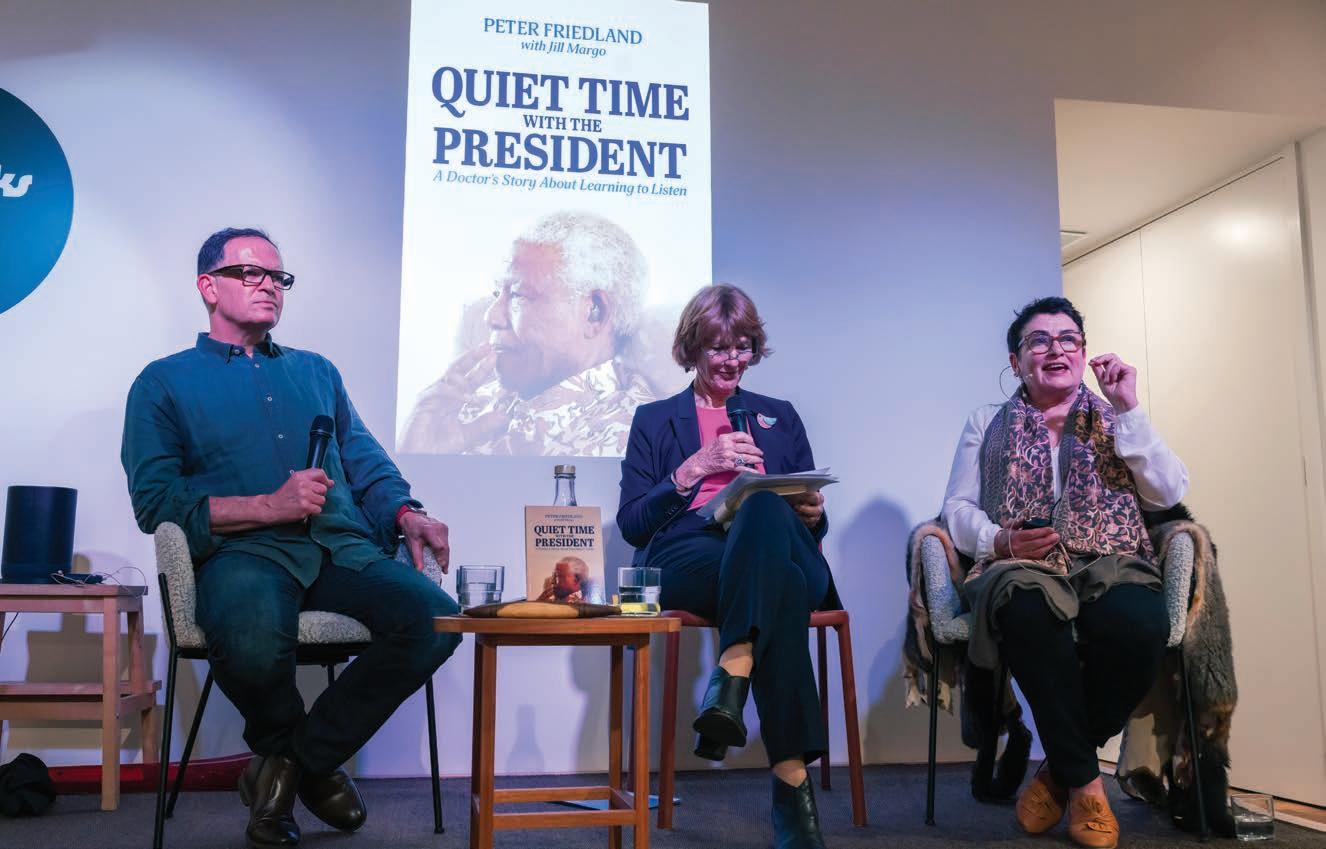
ENT specialist Dr Peter Friedland describes a rather wild life in his recently released memoir, which also explains how he came to care for Nelson Mandela’s hearing in his post-presidential years.
By Ara Jansen
If you’d read Dr Peter Friedland’s CV, it would be easy to think that he’d spent his early years doing battlefield medicine. Constantly dealing with complex bullet wounds, removing a knife from an eyeball and enough casualties in one hospital that post-op patients often had to recover on the floor were not unusual.
It sounds dramatic, but it was pretty normal for a doctor in Johannesburg, South Africa’s largest city.
The other thing you wouldn’t miss on Peter’s CV is that from 2000 to 2009 he was the ear, nose and throat specialist to Nelson Mandela. The lessons he learnt from treating one of the world’s revered statesmen are a big part of Peter’s recently released memoir Quiet Time with the President: A Doctor’s Story about Learning to Listen
Launched in August, the book was co-written with his sister Jill Margo, an author and awarded journalist with the Australian Financial Review.
Apart from meeting his wife, treating Mandela has been the most significant experience in his life. Peter talks about these meetings and other stories about practising medicine in Johannesburg in the book. It’s an interesting and sometimes moving story which easily blends political unrest, medicine and the intimate conversations with Mandela against the backdrop of the end of apartheid.
Refreshingly, the author isn’t shy about revealing his own scars and mistakes either.
No medical confidentiality has been violated in telling these stories and they prove an interesting insight because they come post-Mandela’s presidency, and conversations between just the two of them in Mandela’s home, arguably an incredibly unique point of view.
Naturally, the pair ended up talking widely on different topics, mostly political – ranging from Lockerbie and Gaddafi to AIDS – often taking tea together after the check-up. Peter says, if there’s one wonderful thing he took from their time together, it was how to listen.
A big part of treating Mandela was updating his hearing aids and making sure he could hear what was going on around him. Apart from his role in AIDS awareness, Mandela was also a huge advocate for hearing aids, once saying in a speech that “These little instruments made a big difference to my life. Wherever I go, they help me to listen better, to understand better.”

be diagnosed. It left him almost a quadriplegic and there seemed no chance of remission.
“I witnessed his very poor care and the arrogance of the medical professionals,” says Peter. “I became angry about medicine and very disillusioned with doctors and medicine. I also realised I could make a difference and wanted to be a doctor who spoke to patients with dignity and be able to treat them regardless of whether they could afford it or the colour of their skin.”
otolaryngology and Richard eventually did an MBA and last month, after almost 20 years, retired as the CEO of Netcare, South Africa’s biggest network of private hospitals.
While working in his specialty and becoming father to five children, including a set of twin girls, he was often called on by local emergency departments to help deal with the results of street violence.
From 2005 to 2009, Peter was clinical head of ENT at the University of Witwatersrand Donald Gordon Medical Centre in Johannesburg, where he was instrumental in convening the
Peter’s interest in studying medicine stemmed back to an illness his father had that couldn’t continued on Page 24
Peter and his twin Richard both started their university studies in veterinary medicine and then moved into medicine. Peter went on to do his specialty in


continued from Page 23
first cochlear implant workshop in Africa and performing the first middle ear implant in Africa.
From his early medical years, Peter committed himself to regular pro bono outreach in underprivileged and rural areas and supported and helped manage a school for 300 deaf and underprivileged children in a township outside Johannesburg.
He continues that work in Perth, working with Derbarl Yerrigan Health Service and visiting remote communities in the north of WA as well as working with the Royal Australian Air Force on emergency missions.
He is a loud and enthusiastic supporter of the public health system here and has chosen not to work exclusively in the private system because of his belief in having robust and excellent quality public health care.
“My mother taught us a commitment of service to humanity. You are given a gift if you become a doctor and that is to improve everyone’s lives, irrespective. And that’s what I teach my students – it’s about the dignity of human beings, no matter what they are doing.
“It’s part of why I am so committed to the public system. I had to start in the basement when I arrived here because my credentials were not accepted, so I gradually and quietly worked my way back up.
“I believe public patients deserve the highest standard of care. I also feel very strongly about children on waiting lists.”
He tells his students that he learnt several lessons from spending time with Mandela.
“He told me that every single human has a spark of humanity, and they have their own dignity and own truth. It doesn’t matter if they are Australian, Indonesian, African, Muslim or Sikh. If you look at them with that right to dignity, then it’s hard to be cruel towards them. You have to see the human being in everyone.
“The second lesson he taught

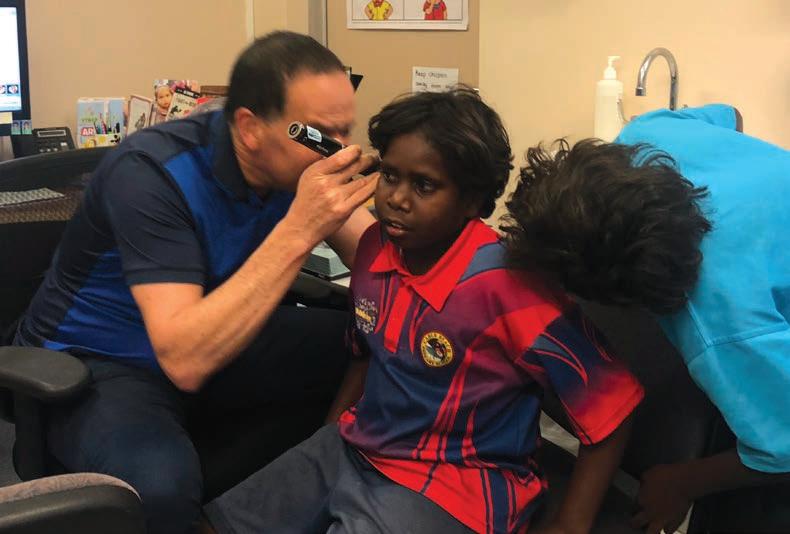
me was how to listen. There’s a difference between hearing something with your ears versus listening with your brain and heart.”
Peter cites a US study where they found that doctors only allowed eight to 11 seconds from when the patient started telling their story to when the doctor interrupted and started talking.
“It’s that doctor drug – you being present and making eye contact with a patient. They feel heard and that in itself is medicine and the start of the healing. Mandela could
hold that silence and really listen to people.
“That’s healing for both sides – you hear their story; you hear their emotions and their history. That was an epiphany for me. I thought I was healing him so he could hear better, but he taught me to listen and that was healing for me.”
Peter’s South African medical experiences also seemed just a little unbelievable to the Australian hospitals looking at his CV when he decided it was time to raise his family in a safer city.
By the time he had turned 47, Peter had lost three of his closest male friends to the city’s everprevalent gun violence, one of whom had bled out in his arms in the carpark of his business and another who was shot in his car as the perpetrator tried to steal it. In the book he also mentions a red car tailing himself and Linda, which later is reported as being responsible for a couple of hijackings.
In 2009, he found a six-month job at Sir Charles Gairdner Hospital and the Friedland family – Linda (a nonpractising doctor and international health consultant) and the children – moved to Perth.
An adult and paediatric ear, nose and throat specialist, today Peter is a consultant ENT at Joondalup Health Campus and SCGH, where he was head of ENT for six years and instrumental in recruiting five new fellowship-trained consultants in head and neck surgery and anterior skull base surgery. He’s also the Garnett Passe Rodney Williams Foundation Professor of Otolaryngology Head and Neck Surgery at UWA and SCGH and
professor at School of Medicine at Notre Dame, where he teaches and coordinates the curriculum for final year medical students.
When he recently turned 60, Peter says it felt the time was right for the book. Alongside his sister they set about writing down all his stories and taking several trips to Johannesburg to fact-check. Peter found his old medical notes and dug out the journals where he documented his thoughts on his chats with Mandela.
South African proceeds from the book are going to hearing charity High Hopes, an early intervention partner for families of deaf and hardof-hearing babies. Locally, Australian proceeds are going to Derbarl Yerrigan Health Service, a group which Peter works regularly with.
“I do pinch myself sometimes about the experience of meeting Madiba (his clan name). It was the highlight of my life. I got to help this incredible human. Being around him, you just felt this energy, like something was happening to you. He could connect with people at a very human level, no matter who they were. He just had something
and he’s part of a very unique group.
“Meeting him has had a huge impact on my life. It has given me an appreciation on the sanctity of life – and an appreciation of the cruelty of humans.”
Now well settled in Australia and proud to be here, Peter says it’s a wonderful feeling to live in a city and feel safe. It’s an indescribable feeling to have such equanimity without the constant vigilance. The peace is priceless.
“I feel incredibly grateful to be here. Madiba might have changed my life, but moving to Australia changed our lives too.
“We love the ocean, and I run a lot. As a family we love the beach and Rottnest. We’ve done a lot of driving trips north. I also have five grandchildren here.”
Quiet Time with the President is available locally and online in hard copy, plus Kindle and audio book format.
Our purpose is to design cancer care experiences that deliver the best possible life outcomes close to home.

In WA, we have 8 metro and regional centres dedicated to offering fast access to care, delivered utilising evidence-based treatment techniques.
*GenesisCare data held on file Scan here to learn more or visit: genesiscare.com

While professional contact sports have garnered most attention, when it comes to concussion, researchers are keen to learn of the experiences of the 80% who are injured in the course of their daily lives.
Eric Martin reports
A team of Australian researchers, involving Curtin University, Edith Cowan University, the University of Notre Dame, and The Kids Institute, have pioneered a new ‘dictionary’ to better predict outcomes for people who have experienced a moderate-severe traumatic brain injury (TBI).
The work of the Australian Traumatic Brain Injury Initiative (AUS-TBI) is supported by the Australian Medical Research Future Fund Mission and examined factors related to social support, health, clinical care, biological markers, acute interventions and long-term outcomes.
Published in the Journal of Neurotrauma (April 2024) as a series of eight articles, the dictionary was informed by a ‘TBI lived experience expert group’ and AUS-TBI Aboriginal and Torres Strait Islander Advisory Group, which helped to shape a culturally unique approach to management of the condition.
The group also partnered with the developers of the Headcheck app, which for almost a decade has been helping Australians recognise the symptoms of concussion and manage their recovery.
Using the app, study participants can track and manage their symptoms over a 12-month period or until their symptoms resolve, while gaining access to information and resources to help their recovery and return to normal daily activities such as study, work, sports or recreation.
Curtin’s Deputy Vice Chancellor Research, Professor Melinda Fitzgerald , has been the lead for both studies. She explained that nationally, 790 TBI cases per 100,000 people annually have been reported, equating to 190,000 to 200,000 cases a year, of which about 20,000 are moderate to severe injuries.
New injuries add $2 billion in lifetime direct costs to the healthcare system annually, with significantly high, ongoing costs faced by some patients. Severe TBI has a mortality rate of 30–40%, and less than 50% of patients achieve long-term independence.
“Despite decades of empirical research, prediction of individual outcomes after TBI remains imprecise. We have only partial understanding of what it is about the person, their injury, their environment, or their care that moderates and/or determines the multiple outcomes that contribute to quality of life,” Professor Fitzgerald said.
“At present, there is no indicator that can sufficiently predict treatment outcome or responsiveness to allow for personalised acute care and rehabilitation for individual patients with TBI. There is an urgent need to standardise approaches to data capture and harmonise measures when assessing interventions and outcomes across sites and contexts.”
She pointed out that the challenge for clinicians was that in a small proportion of people, the symptoms could continue for multiple weeks, “if not months or even years.”
“We don’t understand what it is about a person and their injury that
predicts whether they will recover normally, or if their symptoms will continue. This app is a novel approach to online health data collection and interpretation, and we hope it will help us to understand the experience of more than 5000 people who have had a recent concussion.”
Professor Fitzgerald noted that despite the prominent coverage of sports stars being impacted by TBI, only about 20% of concussions and more severe injuries occur because of accidents on the sporting field.
“There is a considerable proportion of people who experience concussion just in their normal daily activities, such as through motor vehicle accidents, the elderly having falls, and kids having accidents in the playground,” she said.
“Our project is trying to figure out what it is about the person and their injury and their pre-existing health conditions that might indicate whether they are going to recover normally within the first few weeks after injury, or whether they are going to have those persisting symptoms.
“And a key factor is how many other injuries they might have received in the past such as preexisting health conditions, whether they suffer from headaches or migraines in the normal course of their life, whether they have any other mental health conditions, and whether this is their first concussion. Critically, it captures the context of how they experienced their concussion.”
In an international first, that information will be analysed via machine learning to determine the most crucial factors for predicting the outcome for an individual and their injury.
“Previous studies of this nature have confined their attention to some of the basics, such as sex, age, what caused the injury, whether there was any accompanying injury to the skull, and whether the person lost consciousness,” she said.
“Whereas this project is going to be much wider ranging, and because it is such a large suite of data measures and outcomes, we do need the power of machine learning to be able to ascertain the most predictive variable.
“The second phase of the project next year is a refinement of the app to focus on those predictive elements to improve how people are managed following a concussion injury – informing guidance about graded returns to activity or whether they should seek specific medical care based on their symptoms.
“At this stage, we have only been going for a few weeks and the study has enrolled 50 participants, but we are looking for 100 times that – 5,000 people. The studies to date have been limited to hospitals because it is much easier to collect information within that context.
“But that is a fraction of people who experience concussion and up to 50% of people do not even seek medical care. As such, we are getting out in the community so that we capture the breadth of people who suffer these injurie.
“It is extremely exciting and as scientists, we are extremely curious about how the data will pan out.
“Anyone who has experienced a concussion in the past two weeks is encouraged to download the Headcheck app and log in to the AUS-mMTBI study and contribute to that research as well.
“The benefit to the individual is that they will be able to map their symptoms, including a graph of how they evolved over time which they can take back to their GP or other healthcare provider. Diagnostically, that is a real value addition for people who get involved with these studies.”
Professor Fitzgerald said that if people have had a migraine in the past, they had a greater propensity to experience longerterm, continuing symptoms after a concussion or a more severe traumatic brain injury, noting that natural resilience was also a protective factor.
“People who score higher on resilience scales tend to do a little better following a concussion. So, it is a bit about mindset and whether you are the sort of person that tends to bounce back from adversity,” she said.
“But it is not black and white, though if you are looking at
At Perth Radiological Clinic your musculoskeletal (MSK) investigations are reported locally by Perth’s largest team of musculoskeletal and spinal radiology experts.
• Rapid access to high quality scans and image guided injections.
• MRI appointments available evenings and weekends.
• Fast report turnaround times delivered by Perth’s largest team of musculoskeletal and spinal radiology experts.
Radiologists available to discuss the imaging and interventional requirements


PRC MSK sub-specialist, Dr Matt Prentice saysOur rapid turnaround reports expedite the path to appropriate treatment, can rule out serious pathology or help differentiate acute injury from chronic non traumatic conditions.
Please contact your customer relations team for more information or email assist@perthradclinic.com.au
continued from Page 27
factors that give an indication of susceptibility, then that is an interesting discovery. Similarly, there are particular areas or types of lesions in the brain where more severe injuries can be predictive of worse outcomes, which is valuable because most patients do not have a visible injury on a standard CT scan or CAT scan.
“With more advanced imaging using MRI, there are certain imaging features that might be more predictive and could add more detail or information.
“And that is one of the most exciting things about the AUSmTBI study, we are conducting a sub-study to collate these types of images of people's brains, combining that data with blood biomarkers, as well as all the data we are collecting through the app, to build a comprehensive database of markers.
“If we find that there is a particular type of imaging or a particular blood biomarker that is genuinely predictive, it provides a sound justification for introducing this data into standard clinical care.”
Professor Fitzgerald said that her team had been working with the AFL on the new modifications to the Headcheck app, making sure that the code’s practices were in line with the most recent guidelines and advice that have been released by the clinical working groups.
“While players in some of the heavy contact sports like AFL and rugby are expected to experience concussions during play, it was a range of individual sports, such as equestrian, bike riding and gymnastics, where there was also a high incidence of concussions,” she said.
“Care needs to be taken and the return to activity protocols followed carefully in these sports or activities in which an injury to the head can occur. Similarly, in a workplace context, there are specific occupations where people can be exposed to falls from height and similar hazards which make a concussion more likely to occur.”

As the founding CEO of the charitable organisation, Connectivity Traumatic Brain Injury Australia, Professor Fitzgerald said that one of the biggest challenges such groups faced was getting the latest evidence-based care information into the hands of GPs and first responders in community settings.
“It is about implementing the research, and that needs to be occurring hand-in-glove with the scientific process so we can ensure that GPs and other healthcare professionals have the resources that they need to be able to make good clinical decisions regarding the management of their patients’ concussions.
“The RACGP has been highly supportive and disseminated information about our online education courses. There has been good buy-in so far, but it will take even more resources to reach a wider audience and get the best evidence-based knowledge into the community,” she said.
“We need to get the word out there that, in fact, the fall you had when you tripped and banged your head on the ground, was
actually a concussion. And while you are probably going to recover reasonably well, the chances of a good recovery are much better if you are professionally managed and take a graded return to activity by following the appropriate guidelines for recovery.
“Similarly, elderly people are much more likely to suffer concussion and to have more ongoing symptoms if they are on blood thinning medications, are at risk of stroke, or have heart arrhythmias.
“By being able to gather information about what the real range of pre-existing health conditions are, we will be able to document the elevation of risk within these groups.
“We hope GPs will encourage their patients to download the Headcheck app and join the AUSmTBI study – the knowledge we gain will not only guide that person to an improved recovery but develop better recovery pathways for people in the future.”
Amid concerns about a dramatic increase of prostate cancer diagnoses across the globe, Australian efforts are underway for a database to guide better treatment.
An inevitable global surge in prostate cancer is coming, according to experts, with a worldwide doubling of cases to 2.9 million and an 85% increase in deaths to nearly 700,000 by the year 2040.
It is the second most diagnosed cancer in men, and the fifth leading cause of cancer death among men worldwide, with an estimated 1.4 million new cases and 397,000 deaths each year. In Australia, one in five men face a prostate cancer diagnosis in their lifetime.
At a meeting of urologists in Paris earlier this year, a report from The Lancet Commission on Prostate Cancer warned that with ageing populations, even more cases were on the way.
According to the report, the case for prostate cancer screening for all men aged 50–70 years in high-income countries is also strengthening, with improved use of technologies such as MRI and growing evidence for the safety of active surveillance.
Some experts have warned that the medical community worldwide is illprepared for the looming tidal wave of cases, arguing that training more urologists, radiation oncologists, pathologists and radiologists will take too long to meet the demand.
But in Australia, a new partnership between the global men’s health charity Movember and SAiGENCI – the South Australian immunoGENomics Cancer Institute at the University of Adelaide – is working to create a transformative database to prevent and slow the spread of prostate cancer.
By Cathy O’Leary

The Movember SAiGENCI
Transformational Integrated Repository – known as MSTIR – will help researchers develop strategies for clinicians to personalise decisions about prostate cancer care. It will combine a range of prostate cancer data in a single location and then analyse biomarkers, unlock trends and diagnostic pathways to improve the overall management and treatment of the disease.
While many biological and clinical datasets from prostate cancer clinical trials and research studies have been collected, this data has almost always been analysed in isolation.
Now, the world-first integrated database, based in Australia, will harness the power of innovative technologies like artificial intelligence and machine-learning to
analyse existing data from tissue samples and clinical data from thousands of men worldwide enrolled in clinical trials.
This is considered one of the most reliable strategies to identify new biomarkers and make sure each man gets the right treatment at the right time, to stop aggressive prostate cancer from growing, coming back or spreading rapidly.
A beta version of the database is expected to be ready midway through next year, with plans to scale access in 2026.

Medical oncologist Professor Christopher Sweeney, the inaugural director of SAiGENCI, said the collaboration would bring together many types of researchers from all around the world to help unlock a new level of understanding of prostate cancer.
“This is an exciting and promising opportunity that could deliver more accurate diagnoses, more effective treatments and improved outcomes for men battling this disease,” he said.
“At the very heart of this unique endeavour is the international team-spirit and sharing of data which is enabling the repurposing and integrating of existing data.”
Professor Sweeney is a clinician researcher whose primary interest is on the management of genitourinary malignancies, in particular prostate and testicular cancers.
He told Medical Forum that the new database’s use of AI and machine-learning would help make discoveries such as new patterns of genes associated with relapse or the development of cancer.
“We will then use this information and aim to develop specific biomarkers to inform which patients should get which treatment,” he said.
“Researchers are constantly aiming to develop better personalised treatments and we have made
advances in metastatic castration resistant prostate cancer and localised prostate cancer with a lower risk of relapse.
“MSTIR is focused on a group that has not had their tumours and general genes comprehensively profiled – namely high -risk localised and metastatic hormone sensitive prostate cancer.
“By focusing on the early stage of men who have potentially lethal cancers, we hope to identify strategies to prevent relapse from localised disease or progression to resistant disease.”
Professor Sweeney said the impending surge in prostate cancer cases gave more impetus to the Australian project, and the need to think and work smarter.
“A lot of this surge will come from the developing world,” he said.
“There will be a critical need to develop more specific and effective therapies, so all men get the right treatment at the right time, and for the right length of time to avoid futile or needless therapy and decrease costs to society.
“We're incredibly excited to see
what kind of discoveries come out of this.”
In other recent prostate cancer developments, Victorian researchers writing in the Australian Journal of General Practice looked at two conservative management strategies – active surveillance and watchful waiting – that aimed to avoid unnecessary treatment and harm.
They said the distinction between the two approaches was treatment intent, with active surveillance involving close monitoring of low-risk prostate cancer with intent to cure, whereas watchful waiting focused on monitoring for symptoms with the intent to minimise them.
Their research confirmed that both were safe and effective management options, and the decision to choose active surveillance or watchful waiting was determined by life expectancy, disease biology and patient preference.

Blood is vital to the body, but expert Professor Ross Baker says the dire impact of obesity on blood flow needs to be stressed more to patients.
In Australia, two-thirds of adults aged 18 and over are either overweight or obese. This statistic is staggering and takes a moment to fully absorb.
As a clinician, it’s a sensitive topic to discuss with patients, given the complicated nature of this growing epidemic.
With new age weight loss drugs becoming popular, the discussion between patients and doctors about weight loss opens the conversation about the multifaceted long-term impacts of obesity on the body – these include the impact on blood and the way it flows.
Efficient and unobstructed blood flow is vital for many essential bodily functions. When blood flow is hindered in any way, an array of health concerns can arise.
Poor blood flow associated with obesity is a major cause of serious illness and should be discussed as the most important reason for weight loss. There is a medical side to obesity that is known well to the medical fraternity and needs to be continually discussed with patients, to ensure they live long healthy lives.
Having excess weight can lead to structural and functional changes of the heart. Obesity is shown to be linked with disrupted blood flow in adipose tissue and it leads to endothelial dysfunction and diminished vascular density. Together, these alterations mutually lead to tissue hypoxia, inflammation and fibrosis.
Obesity is associated with hypertrophic adipose tissue expansion, which is described by an increase in adipocyte oxygen demand, microvascular dysfunction and rarefaction – all causing predisposition to tissue hypoxia. Bloated adipocytes become increasingly distant and detached from the rarefying vascular network, thus hindering blood flow,
diffusion and oxygenation of the hypertrophic adipose tissue.
Additional adipose tissue in the body requires greater levels of oxygen, and blood flow is vital for tissue oxygenation. As the amount of blood transported to different areas of the body is determined by cardiac output, it is hypothesised that elevated blood flow to adipose tissue may take over the blood flow to the brain, causing diminished cerebral blood flow.
Young obese adults have shown to have lower cerebral blood flow in the left pulvinar of the thalamus and visual association areas, including Brodmann area.
Obese adolescents have shown to have a thicker arterial intima layer compared to normal weight individuals of similar age. This is revelatory of a pro-inflammatory atherosclerotic state and therefore of exaggerated obesity-associated vascular ageing.
Recent research shows that overweight and obese adolescent females at 14 years and women aged 31 years have an increased risk of ischaemic cerebrovascular disease compared to females within a normal weight range. With women having approximately a sevenfold increased risk of ischaemic cerebrovascular disease compared to men for this disease.
The risk of haemorrhagic cerebrovascular disease was seen in both males and females aged 31 years and higher among overweight adolescent girls compared to boys. Obesity, especially among adolescents and young adults, has shown to have serious repercussions on their health, and not only on one or two organs in the body. Excess weight can be associated with several chronic diseases and coexist, increasing the risk of morbidity and mortality. We all know the catastrophic effects of atherosclerosis on the

heart and body. When you add obesity to it, the damage escalates.
In the past, both diseases were seen as ‘lipid storage disorders’ with the accumulation of triglycerides in fat tissue. More recently they are seen as chronic inflammatory diseases.
Inflammation is accountable for all processes which lead to atherosclerosis including endothelial dysfunction and atherosclerotic plaques. The release of adipocytokines from fatty tissue provoke a hypercoagulable state.
Therefore, obesity is a major factor in increasing and accelerating the inflammatory process and the development of atherosclerosis. When it comes to high blood pressure, the structural and functional alterations obesity causes to the heart and volume stress are quite significant.
Excess weight can lead to left ventricular hypertrophy and dilation which results in diastolic and systolic problems along with the build-up of epicardial fat and an enlargement of the left atrium. This then causes circulating blood volume to elevate producing increased cardiac output and stroke volume. And these all lead to the increased risk of developing of hypertension.
Discussing the topic of obesity with patients is a difficult but essential role of physicians, as the risk of not doing so can simply be too high.
Getting your blood moving more efficiently can start with getting the body moving. Exercise is a great way to improve cerebral blood flow and improve heart health even with the lightest of walks is a step in the right direction and will ensure positive outcomes beyond the latest weight loss fad.
ED: Professor Ross Baker is from the Perth Blood Institute.
GPs often work with psychologists, but it is important to understand their endorsements, says Australian Association of Psychologists director Carly Dober
Doctors play a key role in supporting the health and wellbeing of Australians, and psychologists often work closely with GPs in mental health care, offering therapeutic interventions and support.
But navigating the landscape of psychologist registrations can be complex. For GPs who often work with psychologists, understanding the registration types of psychologists is essential for effective referrals and patient care coordination.
All psychologists have completed at least six years of education and training and can all assess, treat, and diagnose mental health conditions.
There are two registration types for psychologists in Australia –provisional registration and general registration.
There is also area of practice endorsement. Endorsement identifies psychologists who have completed an approved postgraduate qualification and supervised training and can use a protected title associated with one of the nine areas of practice.
Endorsement is a regulatory mechanism and is represented as a notation on a psychologist’s record on the public register of practitioners. Endorsement should not be confused with specialisation.
Endorsement does not restrict the scope of practice. The only practice limitations for psychologists relate to their knowledge and skills and their obligation to practise within the boundaries of their own scope of competence.
In addition, endorsement should not be confused with areas of professional interest or expertise. Psychologists upskill themselves in an area of professional interest through continuing professional development, training and experience.
There are no mechanisms in place to acknowledge further training and expertise garnered after post-graduate study, and these activities, no matter how extensive or professionally valued, are not currently acknowledged or applicable in the endorsement system. Nor is further post-graduate study undertaken in areas such as trauma, addiction, public health, PTSD and eating disorders.
Endorsement is optional. Of the 38,000 psychologists in Australia, fewer than 17,000 have an area of endorsement.
Psychologists with general registration undertake an accredited undergraduate degree and one or more recognised postgraduate qualifications in psychology. This is followed by a supervised practice training program or internship. Interns offer a broad range of psychological services and interventions.
Those with clinical endorsement have completed post-graduate education in clinical psychology and two years of supervised training as part of a registrar program, while those with counselling endorsement might work providing counselling services to individuals, couples, and families, often addressing developmental, emotional and relational issues.
Individuals with educational and developmental endorsement have received additional training in and focus on assessments, particularly with children and adolescents in educational and developmental contexts.
Psychologists with clinical neuropsychology endorsement assess and treat individuals with neurological, medical, neurodevelopmental and psychiatric conditions. Their work involves neuropsychological testing to diagnose and create treatment plans for conditions such as traumatic

brain injury, stroke, dementia, and other cognitive impairments.
Those with forensic endorsement apply psychological principles within legal and criminal justice systems.
Psychologists with organisational endorsement focus on workplace behaviour and are focused on improving productivity, job satisfaction, and overall workplace wellbeing. They often engage in employee assessments, training and development programs, and organisational development strategies.
Psychologists with health endorsements collaborate with medical professionals to address issues such as chronic illness management, pain management, and health behaviour change. Health psychologists play a valuable role in hospital settings.
Those with sport and exercise endorsement focus on the psychological aspects of sport and physical activity. They work with athletes, coaches, and teams to enhance performance, motivation, and recovery, and address issues such as anxiety, burnout, and injury rehabilitation.
Provisional psychologists are students in their final years of supervised practice and training. They are registered with Ahpra and have completed their undergraduate and honours degree in psychology, as well as a Masters program.
GPs are often the first point of contact for patients seeking mental health support. Understanding the different psychologist registrations enables them to make informed referrals based on patient needs and the psychologist's areas of expertise and interest.
It is important to provide the client with the agency if they have a
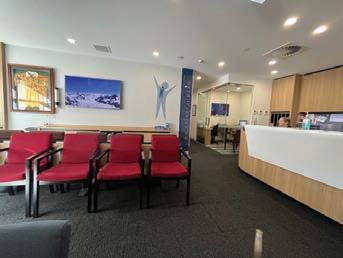

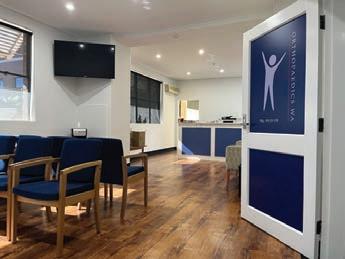










As more research delves into the gut-brain axis, Curtin University’s Georgia Brice looks into how diet can improve mental health for multiple sclerosis sufferers.
There are more than 2.3 million people worldwide and more than 33,000 Australians who have multiple sclerosis and experience mental health challenges – an issue recently highlighted by American actress Christina Applegate.
This chronic inflammatory immunemediated disease of the central nervous system is commonly diagnosed between the ages of 20 and 40, with women being three times more likely to develop the condition. While it can be treated with disease-modifying medications, there is no cure.
Mental illness is more common in people living with MS (depression 27%, anxiety 35%) compared to the general population. Symptoms such as fatigue, pain, cognitive impairment, and living with disabilities are associated with depression and anxiety in people living with the condition, affecting their quality of life. These symptoms can cause worry and difficulty in planning and disrupt routines.
Additionally, people living with MS report feelings of grief as they are not able to do things they were once able to do. There are also challenges associated with navigating the invisibility of some MS symptoms, which health professionals and support networks often misunderstand.
Despite the greater prevalence of mental illness in people living with MS, they often are underdiagnosed.
Health professionals and people living with the condition often struggle to differentiate whether symptoms, such as low mood, are the result of the disease process, disease-modifying medications, or psychosocial causes.
A lack of access to mental health services for people living with MS has also been shared by people living with the condition and health professionals, leaving some without mental health support.
To cope with the challenges of living with MS, people use lifestyle adjustments, including making dietary changes. These changes can improve the overall wellbeing and improve symptoms, mental health, and quality of life.
Recent findings suggest that diets high in fruits, vegetables, lean meats, whole grains, fish, and nuts and low in processed foods can improve symptoms and mental health for people living with MS. These diets can lower inflammation and improve connections between the gut and the brain, vital for people living with MS.
Furthermore, recent reviews have highlighted several factors, including genetics, gut microbiome changes, demyelination, inflammation, and structural and functional brain changes, that might contribute to this greater prevalence of mental illness in people living with MS.
They also have emphasised the influence of gut health on the central

nervous system, implicated in MS development and progression. Specifically, diet has a predominant influence on the gut-brain axis, whereby the gut and the brain have a bi-directional relationship. In other words, the relationship between mood and food is bidirectional, where mood can affect food choices and vice versa.
The Australian Dietary Guidelines provide food group and nutrient intake recommendations to improve health and wellbeing. These recommendations include consuming various foods from five food groups daily and limiting alcohol intake, added salts, added sugars, and saturated fats.
However, less than 4% of Australians achieve these food group and nutrient recommendations. Moreover, these recommendations are targeted at the general population rather than to meet the specific needs of people living with MS.
Future research is investigating the relationship between mental health and diet in people living with MS, in addition to how this relationship might differ between people living with the condition and the general population. Overall, current research suggests that a healthy diet may enhance the wellbeing of people living with MS.
ED: Georgia Brice is a PhD candidate at Curtin University exploring the relationship between mental health and diet in people with MS.
and healthcare systems. By raising awareness of psychologist roles and registrations, GPs contribute to reducing stigma and promoting access to mental health care. The right psych
continued from Page 33
preferred psychologist they have researched and talk to them about the type of rebates they can access
if they are eligible under the Better Access scheme.
GPs can advocate for the importance of mental health services within their communities

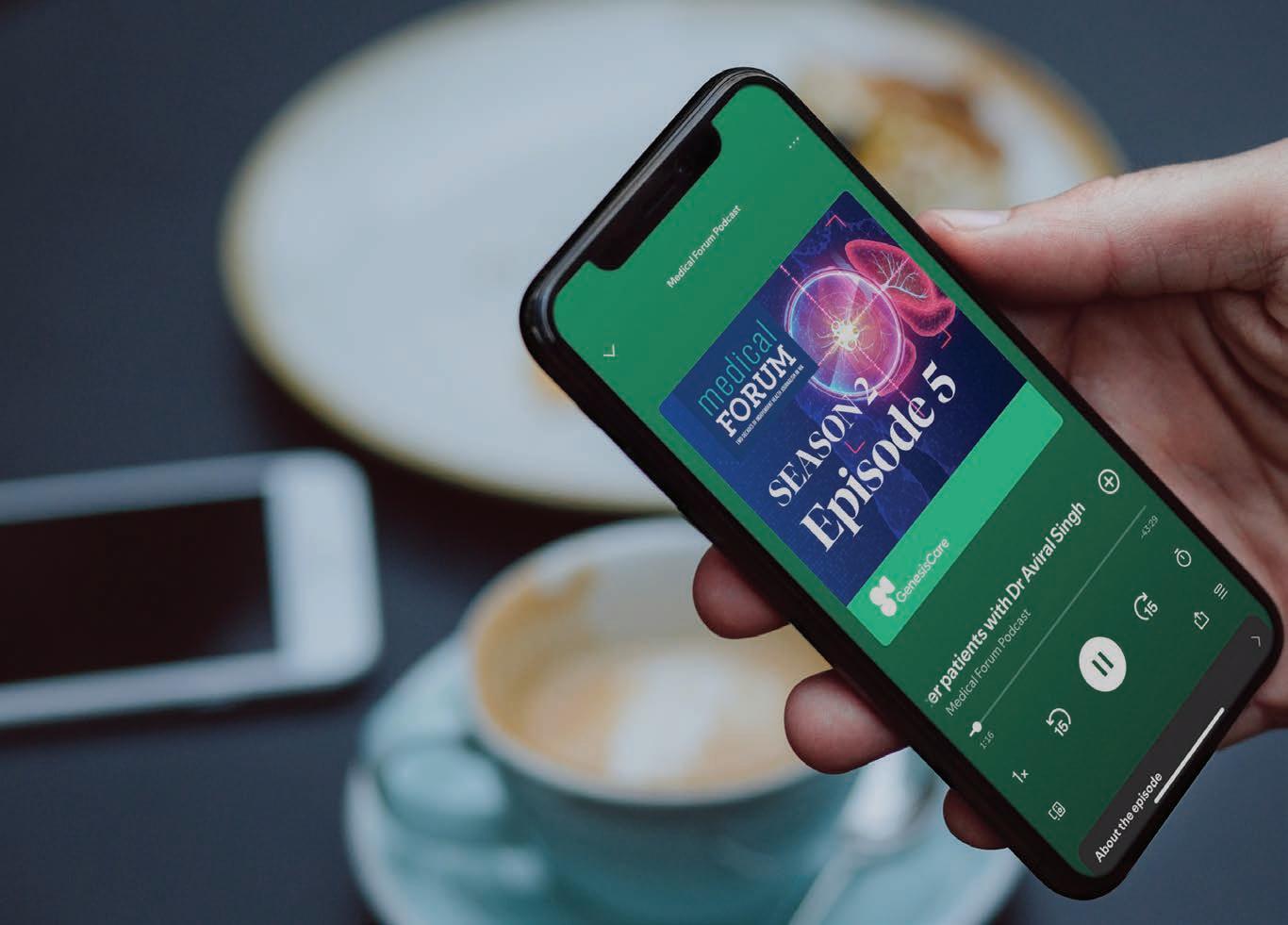
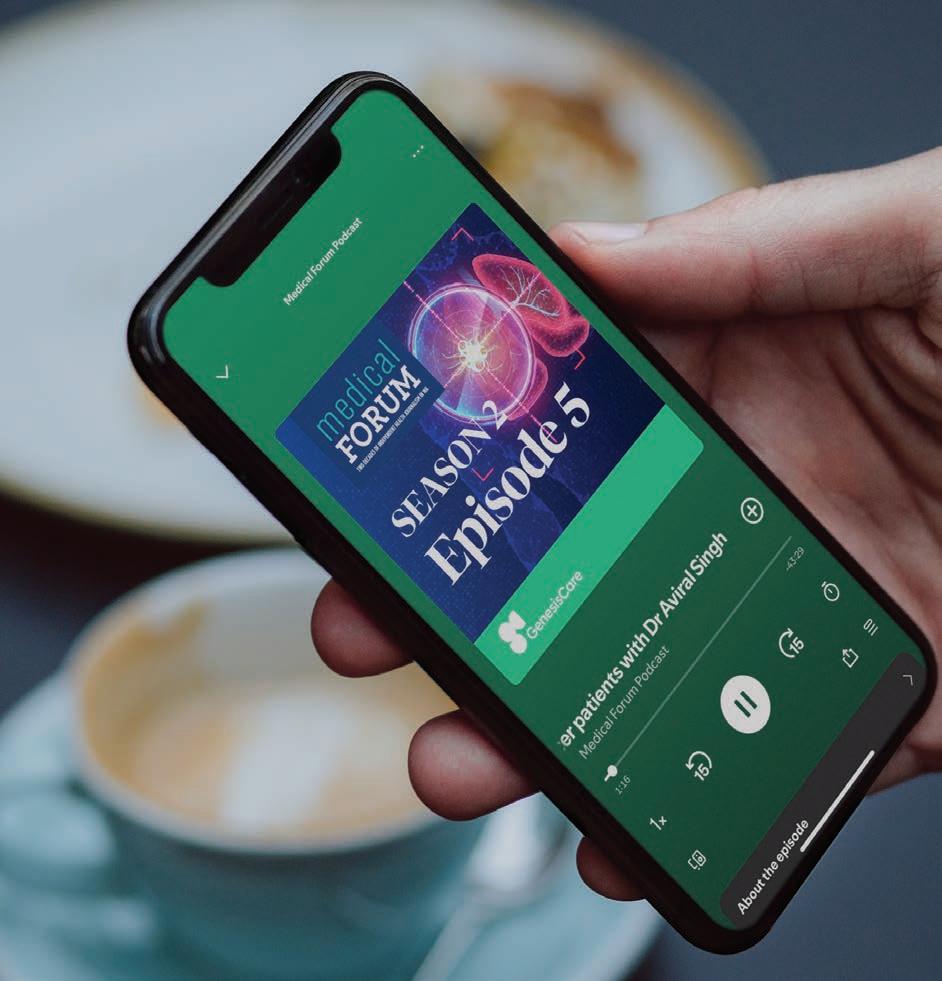


Medical Forum podcasts bring you key insights to new treatment options available in WA from local specialists.
Join our clinical editor Dr Joe Kosterich as he interviews specialists across the disciplines to keep you abreast of developments that could improve outcomes for your patients.
Perfect for a spot of CPD on your drive to work.
Topics covered this series:
A new skin cancer treatment available in Perth
Aortic Stenosis diagnosis and management
Acute disk service
An introduction to theranostics – precision oncology treatment

Follow us on Spotify using the QR code
Dr Joe Kosterich |

we
Data can be revealing and staggering. In the US, rates of autism have risen from one in 10,000 in the early 1960s to one in 36 nationally and one in 22 in California.
Some 40% of American children and 60% of adults have been diagnosed with a chronic disease. The obesity rate is 40%. In Japan it is 3%.
In Australia we don’t do as poorly, but rates of all the above have also increased significantly. What caught my attention was that when it was highlighted, nobody is asking the obvious question – why?
As doctors we rightly focus on the patient in front of us and don’t always look at the big picture. Better recognition plays a part in increased diagnostic rates but cannot explain them all.
We can point to people eating more and being more sedentary, but this is a worldwide phenomenon, and it appears that the Anglosphere is disproportionately impacted compared to European and Asian countries. Why?
It is unlikely that there is one cause. Some could be explained by our tendency to lower thresholds at which conditions (e.g. hypertension and hypercholesterolaemia) are diagnosed as well as widening diagnostic criteria in mental health. Part could be better capacity to test and diagnose.
This doesn’t explain cross country differences – especially between countries having similar economic circumstances.
The next question is why is nobody seriously looking to answer the question? This one is easier to answer. It is increasingly difficult to ask difficult questions and even harder to get any funds to answer them.
Dr Marty Makary of Johns Hopkins asks a different question in his latest book, Blind Spots. Could it be that many modern-day health crises have been caused by the hubris of the medical establishment? And are we guilty of groupthink? Ouch!
Makary claims when we get it right, we shine. But when we get it wrong, we fail to fess up! He has a point, especially when it comes to organisations and government departments rather than individual doctors.
First do no harm has been fundamental in medicine but we have deviated. Maybe we need to look dispassionately in the mirror at the good the bad and the ugly of medicine. And then turn our thoughts to the why.
By Dr Li-On Lam, Orthopaedic Surgeon, Murdoch
The first joint replacement of any kind was a shoulder replacement. This was performed by a French surgeon in 1893 for the treatment of tuberculosis. Like most things in medicine, much progress has been made.
Early implants were constructed using ivory, plastic then metal. Initially, only the humeral side was replaced then experiments with glenoid components began. These early designs were plagued by loosening and instability.
These innovations evolved into anatomic replacements with a monoblock humeral prosthesis and a polyethylene glenoid component. Modularity was gradually introduced to adapt the replacement to the patient’s anatomy and there arose the concept of a resurfacing where
a metal shell resurfaced the patient’s humeral head with the option of a glenoid component being implanted as well. Furthering this concept, mid-head replacements consist of resecting the humeral head allowing better access for glenoid replacement.
The gap left by cuff deficient shoulders or fractures, where the rotator cuff deficiency leads to ‘rocking’ of the humeral implant on the glenoid causing loosening or instability of the implant, led to the development of the reverse shoulder replacement.
Paul Grammont is seen by many as a central figure in the development of this prosthesis where his design principles of medialisation of the centre of rotation and lengthening of the deltoid provided for stability and optimisation of deltoid function.

Our Australian Joint Registry informs us that since 2008 there has been a 227.8% increase in the number of shoulder arthroplasties performed. Of these, 71% are of the reverse variety. This is due to the expanding indications for the procedure – cuff arthropathy, pseudo-paralysis from cuff deficiency, proximal humeral fractures and arthritis in the cuff-atrisk patient (e.g. elderly, those with partial thickness cuff tears).
The use of primary stemless implants in anatomic total shoulder arthroplasty has increased 825% since 2012, with revision rates of 4.6% at 10 years.
Surgeons are obtaining CT scans in 70% of patients, preoperatively. These scans assess



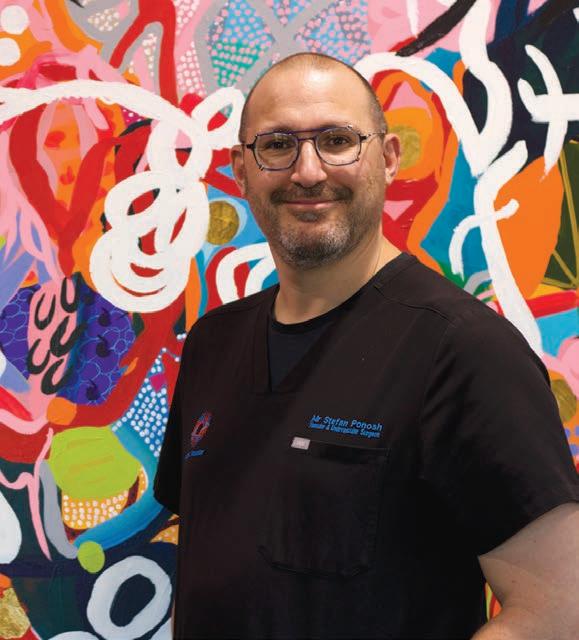
The first ever joint replacement was the shoulder
Since 2008 there has been a significant increase in shoulder arthroplasties
Virtual reality allows 3D planning of surgery.
glenoid morphology, in particular. Posterior glenoid erosion is a common pattern of wear in the arthritic shoulder and CT allows assessment of bone loss and glenoid version. There are now implants which use metal augmentation to accommodate bone loss, and custom implants can be manufactured in the case of severe bone loss.
CT scanning allows accurate 3-dimensional visualisation and pre-operative planning. Modelling of the range of motion, risk of impingement and lengthening of the arm can be done which will hopefully reduce the risk of instability, notching of the humeral
prosthesis on the glenoid neck and allow better soft tissue tensioning, reducing the risk of scapula fracture. Integration of wearable technology with smart devices can assist in reminding patients to perform exercises, track range of motion and complement physiotherapy. Alerts can be set if patients fall behind in meeting milestones.
Enabling technology such as custom guides, navigation and augmented reality are here. These help placement of the implants and correction of version.
Virtual reality visualisation and manipulation of a 3-dimensional plan is coming, which will allow doctors and patients to see a vivid surgical plan. This will also no doubt fascinate and entertain patients as they watch their surgeons pinch and point in thin air as they manipulate things in their virtual world!
As the number of replacements increase, so will the challenge of revision procedures. Encouragingly, the proportion of revision cases
continued on Page 40
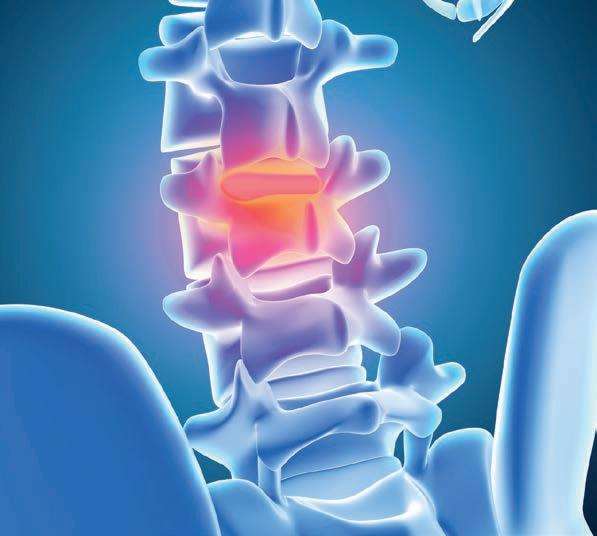


By Prof Peter O’Sullivan, Curtin University
Low back pain is the leading cause of disability worldwide. There is strong evidence that in the absence of serious pathology (such as nerve compression, malignancy, fracture, infection affecting 1-5% of people), low back pain is associated with a combination of biopsychosocial factors than can result in sensitisation of spinal structures. While findings on MRI (such as disc degeneration) may be associated with a person’s low back pain, they are poor predictors of their levels of pain, disability and future trajectory. Stronger predictors of pain chronicity include negative back pain beliefs, pain-related fear and distress, leading to over-protection and avoidance of movement and activity.
Care for people with low back pain in Australia is often discordant with the evidence-based guidelines. Few treatments offer lasting benefits, while the costs of treatments for people with low back pain escalate.
In response to this, the Australian Commission for Safety and Quality in Health Care released a Clinical Care Standard for low back pain in 2022.
The standard is aligned to best

care guidelines for people presenting with low back pain. It was developed and endorsed by all key professional groups who treat people with low back pain, in conjunction with patient advocacy groups. The standard has
continued from Page 39
reduced to 7.9% in 2022 compared to the peak of 10.9% in 2012. Periprosthetic fractures and infections are also challenges, all in more medically complex and older patients. Surgeons are increasingly sharing care with their microbiology and geriatrician colleagues to optimise patient management in these cases.
Practice points
Consider an x-ray for patients
presenting with the painful shoulder. Many have only ultrasound then a subacromial injection. Injecting an arthritic shoulder has a small risk of infection greatly increasing the stakes should the joint come to replacement.
In the unhappy anatomic shoulder replacement, consider cuff failure. Look for signs of a high-riding humeral head for example.
In the reverse arthroplasty, assess for loosening, looking for radiolucent lines. An x-ray will also

implications for all clinicians who treat people with low back pain, with a challenge for better interprofessional collaboration.
Key elements of the standard include:
1. Screening for serious pathology
2. Psychosocial assessment to identify potential barriers to recovery
3. Reserve imaging for suspected serious pathology
4. Patient education and advice
5. Encourage self-management and physical activity
6. Provide interventions that target physical and psychological barriers to recovery
7. Judicious use of pain medicines
8. Review and referral.
Cognitive Functional Therapy for people with disabling low back pain
Cognitive Functional Therapy (CFT) is a physiotherapist led personcentred intervention for people with disabling low back pain, once serious pathology is excluded. It identifies and targets both the physical and psychosocial barriers to recovery in people with disabling low back pain and coaches them to self-manage their pain. The intervention takes up to eight
show a dislocation which can be a surprisingly painless condition but leads to loss of function. Scapula spine fractures can lead to a sudden loss of function in the reverse shoulder replacement and may need a CT to make the diagnosis.
Author competing interests – nil
Low back pain is the leading cause of disability
Low Back Pain Clinical Care Standard provides a roadmap for best care
Coaching people to self-manage their pain has long term benefits.
sessions over six months, and the sessions are longer than traditional physiotherapy sessions.
The key elements of CFT include:
1. Making sense of pain: helping people make sense of their pain from a biopsychosocial perspective and build a positive mindset towards their condition and recovery.
2. Exposure with control: guiding people to build confidence in their back to re-engage in valued activities that are painful, feared or avoided, without over protection, and in a graduated manner.
3. Healthy lifestyle: coaching engagement in physical activity
based on their preference, healthy sleep and eating habits, and stress management skills.
A multi-centre clinical trial of CFT (RESTORE) was published in the LANCET in 2023. The trial included 492 people (over 18 years) with disabling low back pain, many who had previously failed numerous interventions.
CFT resulted in large and longlasting reductions in pain and disability, compared to usual care for people with disabling low back pain. People reported a more positive mindset toward their condition, less fear of movement and great confidence to engage in valued activities. It resulted in over $5000 cost savings due to people getting back to work. It was safe and people liked it.
CFT is broadly in line with the recommendations of the Low Back Pain Clinical Care Standard and provides hope to people with disabling low back pain that recovery (even after numerous failed interventions) is possible.
Call to action
The adoption of the standard and
Heel pain is a frequent problem that presents to the general practitioner. Plantar fasciitis is the most common cause of under the heel pain. Most patients will improve with non-operative treatment but not all.
Surgery is a very effective form of treatment for this condition in patients with long standing refractory symptoms.
Before being considered for surgery patients should undergo at least six months of non-operative treatment that includes the following (in the appropriate order):
• Rest, avoidance of activity
• NSAIDs, stretching exercise program
• Orthotics: off the shelf or custom
• Cortisone injection (one only)
• Shockwave therapy

Surgery can be open or endoscopic. The principle part of the procedure is release of the plantar fascia near its origin on the heel. Historically only the medial half was released but recent literature supports more complete release.
treatments such as CFT require a different approach for clinicians, once serious pathology has been excluded. This involves a focus away from only treating the ‘symptom’ of back pain, towards a whole person empowerment model that involves guiding people towards effective self-management skills. This is in line with best practice approaches for other chronic health conditions such as depression, asthma, diabetes and heart disease. This approach involves the upskilling of clinicians to competently deliver the intervention, as well as greater interdisciplinary collaboration to better support people living with disabling low back pain.
– References available on request
Author competing interests – Member of the working party that developed the Low Back Pain Clinical Care Standard and Developer of Cognitive Functional Therapy intervention, lead trainer of physiotherapists in the RESTORE trial and author on the LANCET publication.
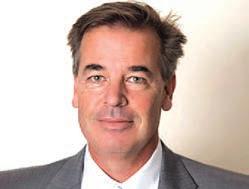
Open surgery is performed through a 3cm incision in the proximal arch and allows not just plantar fascia release but also decompression of the tarsal tunnel and Baxters nerve which is often implicated in heel pain.
Endoscopic plantar fascia release is indicated for those without nerve compression symptoms and is done through a much smaller incision using a camera assisted cutting device much like a carpal tunnel release.
Both open and endoscopic releases are performed as day cases and require approximately two weeks on crutches. Recovery is slightly quicker for endoscopic patients as you would expect. Patients can expect an 8090% chance of a good result from surgery. Complications are rare.


St John of God Medical Centre
Suite 10, 100 Murdoch Drive, Murdoch WA 6150 Telephone: (08) 6332 6300
(08) 6332 6301
www.murdochorthopaedic.com.au
By Dr Dan Marshall, Orthopaedic Surgeon, Murdoch
Foot pain is a prevalent issue affecting people of all ages and lifestyles. Given the complexity of the foot's structure, which comprises 26 bones, 33 joints, and over 100 muscles, tendons, and ligaments, with up to five times the load of the patient’s body weight going through the foot and ankle, it's not surprising that many people experience foot pain at some point in their lives.
Foot pain can result from numerous factors including injury, overuse, obesity, congenital and acquired deformities, medical conditions, and improper footwear.
Plantar fasciitis, a leading cause of foot pain, is also one of the most difficult to treat successfully. It occurs when the plantar fascia, a thick band of tissue running across the bottom of the foot, becomes inflamed and degenerative.
Contributing factors include flat feet, tight calf muscles, excessive
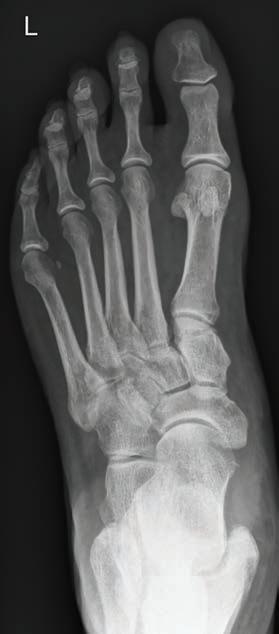
loads (i.e. being overweight), repetitive strain or overuse. Symptoms include sharp, stabbing pain in the heel, especially in the morning or after long periods of rest.
An important differential diagnosis is tarsal tunnel syndrome, which can be distinguished by taking a pain history and performing a Tinel’s test around the tarsal tunnel to see if the pain is reproduced. The plantar heel spur seen on x-rays is not the cause of plantar fasciitis, but a sign of long-term stress on the plantar fascia and deep muscle layers of the foot.
Achilles tendinopathy affects the Achilles tendon either at its insertion into the calcaneum or in the tendon substance, or both. It is often caused by overuse, sudden increases in physical activity, or improper footwear, leading to pain and stiffness in the back of the heel. It is common in the middle aged, patients with diabetes and overweight individuals.


Hallux Valgus (Bunions) result from exposure of the medial first metatarsal head. Hallux valgus occurs when there is widening between the first and second metatarsals (primary metatarsus varus) resulting in lateral subluxation of the sesamoids and resultant lateralisation of the flexor and extensors to the big toe.
The big toe is pulled laterally and can then push against the adjacent toe, causing hammer toe deformities of adjacent lesser toes, most commonly the second toe. The uncovered medial first metatarsal head rubs on shoes sustaining microtrauma and bursal thickening and ossification, known as bunions. This condition can cause significant discomfort, particularly when wearing tight or narrow shoes.
Hallux rigidus is a degenerative arthritic process resulting in pain and a functional limitation of motion of the first metatarsophalangeal joint. It can be the result of trauma, repetitive micro-trauma or

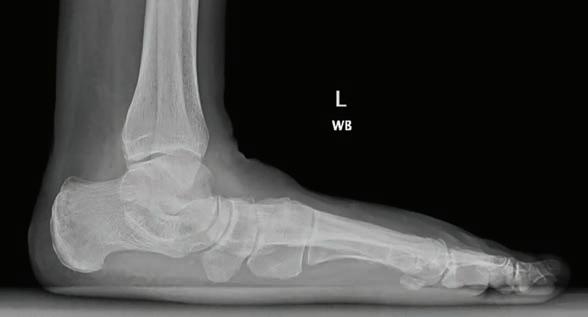
Foot pain is common and has many causes
Accurate diagnosis starts with history
Weight bearing x-rays is first line imaging.
anatomical variants in the first ray.
Metatarsalgia is characterised by pain (worse with activity) and inflammation on the plantar aspect of the metatarsal heads, often resulting from high-impact activities, forefoot deformities or wearing poorly fitting shoes.
Stress fractures are typically caused by repetitive force or overuse. Common in athletes and those engaged in high-impact sports, symptoms include localised pain, swelling, and tenderness that intensifies with activity.
Morton’s neuroma is a compressive neuropathy involving thickened tissue around a nerve or swelling and fibrosis of the nerve itself, causing pain, tingling, or numbness between the toes. The most common site is between the third and fourth toes (third webspace) but can involve all web spaces.
It is seen commonly in middleaged woman with narrow, long feet that have always had problems finding appropriate fitting shoes. Radiographically, there is little room between the metatarsal heads where the interdigital nerves run.
Pes planovalgus (flat feet) may cause discomfort due to tibialis posterior tenosynovitis or sinus tarsi/sub-fibular impingement, while cavovarus (high arches) can increase pressure on the lateral aspect of the heel and plantar forefoot. These conditions can lead to arthritis of multiple foot joints. Arthritis can also cause significant foot pain.
Accurate diagnosis of the underlying cause of foot pain is essential for effective treatment. A targeted medical history is crucial in understanding the nature, duration, and onset of foot pain. Focus on the patient’s pain profile (level of pain, pain at rest, mechanical, resting or neuropathic, exacerbating and relieving factors), activity level, medical conditions, and any recent injuries.
A physical examination should assess the hindfoot alignment (valgus, neutral or varus), foot's appearance (flat or high arched, bunions, callosities), range of motion, and areas of tenderness or swelling. A documented neurovascular assessment of the limb, height and weight (BMI) is imperative.
Weight bearing foot and ankle X-rays are the cornerstone to detect fractures, dislocations, arthritis and deformities. Magnetic resonance imaging provides detailed images of cartilage and soft tissues, including muscles, tendons, ligaments, and nerves. It is particularly useful for
diagnosing conditions like arthritis, tendinopathies, plantar fasciitis, neuromas and stress fractures.
Ultrasound is often used to assess conditions such as tendonitis, bursitis, neuroma and plantar fasciitis. My preference before surgical intervention is obtaining a more detailed MRI especially in neuroma surgery. Ultrasound is most useful for guiding local anaesthetic/corticosteroid injections into specific areas for diagnostic and therapeutic purposes.
A CT scan provides detailed cross-sectional images of the foot, which can help diagnose and classify fractures or assess bone abnormalities not clearly visible on x-rays. A weight bearing foot and ankle CT provides even better structural imaging in complex foot and ankle deformities when planning surgery using 3D modelling. Blood tests are useful for markers of inflammation (WCC, CRP, ESR) or autoimmune disorders, such as rheumatoid arthritis or gout. Nerve conduction studies and EMG have little use in the diagnosis of foot pain. A bone scan may be recommended to detect stress fractures, infections, or bone tumours that are not visible on standard imaging. Rarely a biopsy of the skin, tissue or bone may be performed if there is suspicion of infection, tumour, or certain types of arthritis.
Author competing interests – nil
A WA report has raised questions about the evidence in relation to the condition termed chronic traumatic encephalopathy neuropathological change.
Dr Lauren Fortington, an injury epidemiologist from Edith Cowan University, and a team of international researchers have queried the findings of a wellpublicised 2022 article which claimed, “convincing evidence of a causal relationship between repetitive head impacts (RHI) and CTE.”
“Scientific consensus on RHIs and CTE-NC is lacking – we don’t have a clear understanding of what the exposure and outcomes are, and we don’t have suitable ways to accurately record them,” she said.
“We have weak definitions and inconsistent measurements of the exposure to the proposed cause
at one end, and a lack of consistency in identifying the outcome at the other, because pathologists have struggled to develop agreement on what the thresholds for CTE are, and how to reliably distinguish CTE from other conditions,” she said.
“And in between exposure and outcome, in our view, it isn’t clear whether there is a clinical syndrome that distinguishes CTE from other health conditions that can occur in middle and older age.
“Until the findings of several high-quality studies are published, the scientific community, and all those who distribute research findings, must be more critical of causal claims in this field.”
By Jordan van der Westhuizen, Occupational Therapist, Perth
There are no ‘fun-runs’ or coloured ribbons for low back pain, nor are there fundraisers or charities, yet approximately 80% of people will experience a debilitating episode of low back pain (LBP) during their lifetime.
It has become a significant health concern worldwide, impacting individuals across all age groups and activity levels. It is one of the leading causes of disability and reduced quality of life, with substantial economic implications due to lost workdays and healthcare costs. Despite its prevalence, the treatment of LBP often remains a complex and frustrating challenge, primarily because traditional approaches focus more on managing pain rather than identifying and addressing its root causes.
Movement dysfunction is a critical factor in the development and perpetuation of LBP. Movement dysfunction refers to abnormalities in the way a person moves, which can place undue stress on the spine and surrounding structures. Improper movement patterns are not only a symptom of LBP but also a significant contributor to its onset.
Over time, these dysfunctional movements can lead to mechanical overload on the lumbar spine, resulting in tissue damage, inflammation, and pain.
A key to effectively treating low back pain lies in understanding that it is not a monolithic condition but a spectrum of disorders with distinct mechanisms and contributing factors. Central to this understanding is the premise that LBP arises from specific mechanical, anatomical, and physiological factors unique to each patient.
Unlike generalised approaches that apply a one-size-fits-all regimen of exercises or interventions, a more targeted approach emphasises the importance of identifying the precise cause of pain. Thus,


Movement dysfunction leads to pain and injury
Identifying the specific mechanisms is the vital first step in the rehabilitation process
Movement proficiency is an essential component in addressing low back pain.
identifying the specific mechanisms at play in each person’s context.
The process of addressing LBP begins with a comprehensive assessment, in which the clinician conducts a series of tests and observations to pinpoint the exact source of the pain. This detailed analysis includes evaluating the patient’s movement patterns, as well as the specific loads, postures and positions that trigger pain.
By identifying specific pain triggers and the mechanical dysfunctions, the clinician can develop a clear understanding of the patient’s condition, which forms the foundation for a personalised rehabilitation plan that targets the underlying causes of pain, rather than merely treating the symptoms.
Movement proficiency as a path to recovery
Once the dysfunctional movement patterns and mechanisms have been identified, the focus shifts to
improving movement proficiency and building a foundation for pain-free movement. Movement proficiency refers to the ability to perform movements in a manner that is biomechanically sound and efficient, minimising stress on the spine and other structures.
The foundation of the initial phase of rehabilitation is centred around spinal hygiene, which involves educating the patient on efficient spine-sparring movement patterns to assist with desensitising the aggravated tissue(s). From there, building spinal stability and functional capacity through an individualised exercise program and the development of movement proficiency.
In addition, patients are guided through a progression of movement re-education. This involves building a person’s capacity to perform everyday tasks such as bending, lifting and carrying in a manner that limits the stress placed on the lumbar spine. For example, patients may learn how to hinge at the hips rather than rounding the lower back when bending forward. Over time, these new movement patterns become ingrained, improving the performance of tasks and reducing the likelihood of future low back issues.
In conclusion, low back pain is a multifaceted issue that requires a comprehensive and individualised approach to treatment. Recognising the role of movement dysfunction
By Professor Minghao Zheng, Perron Institute & UWA
Findings of a recent international study involving WA researchers point to the potential application of mitochondrial therapy for some bone-related diseases. The study published in the scientific journal Nature Communications has delivered new insights on the interactions between osteocytes as bone formation regulators and transcortical vessels (TCVs) that are a crucial part of the vascular system for bone and bone marrow homeostasis.
The results were exciting because they have opened the possibility of a molecular therapeutic approach for bone diseases associated with vascular damage. As well as providing the body’s structural support, skeletal bones host blood stem cells (hematopoietic cells) which regulate the body’s immunological system and blood cell production.
Blood vessels are widely distributed in bone and this vascular network plays a critical role in controlling bone development and wound healing. The network also provides a microenvironment for the differentiation and maturation of hematopoietic and immune cells in bone marrow. The link between blood diseases and skeletal health has been well documented, for example, the association between anaemia in older populations and bone fragility.
Inside the hard shell of skeletal bone tissue, blood production cells, including immune cells, erythrocytes, platelets and leukocytes require an extensive vascular network to migrate rapidly from the bone marrow and reach the general circulation in responding to various physiological and pathological conditions.

New research suggests a potential for mitochondrial therapy in some bone diseases
Cellular interactions within bone and bone marrow and this vascular system were found
A crucial role of osteocytes in the regulation of vascularisation in bone tissue was found.
To achieve this, there is a highly vascularised periosteum (outer layer) around the hard shell of bone also connected to the general circulation of the body. Recently it has been discovered that there are TCVs across the hard shell of bone enabling the connection of bone marrow to the periosteum.
While TCVs provide effective communication between the bone marrow vascular system and external circulation, it has not been clear how these TCVs are maintained

and regulated in the body.
This study revealed a crucial role of osteocytes in TCV vascularisation, showing that these cells maintain a normal TCV network by transferring mitochondria to endothelial cells in cortical bone. The research showed for the first time that osteocytes in cortical bone stretch their dendrites with endfeet-like structures to endothelial cells and directly communicate with the TCVs’ network.
The acquisition of osteocyte mitochondria by endothelial cells maintains normal functions by alleviating oxidative stress, promoting cell proliferation, advancing tube formation and restoring the migration capability of endothelial cells. It efficiently restores endothelial dysfunction, accelerating blood vessel formation and healing of the cortical bone defect.
In contrast, the study found that partial ablation of osteocytes causes TCV regression. Blood vessels widely distributed in bone are necessary for bone and bone marrow homeostasis – the set of interactions that result in overall maintenance of bone mass.
The results of this study are important because they provide new insights into this vascular system and its cellular interactions within bone and bone marrow. A crucial role of osteocytes in the regulation of vascularisation in bone tissue has been identified. They inspire the potential application of mitochondrial therapy for bonerelated diseases.
– References available on request
Author competing interests- the author was involved in the study described
in the development of LBP is crucial for effective rehabilitation.
By focusing on improving movement proficiency, individuals can achieve long-term relief and reduce the risk of future pain
episodes. This approach not only addresses the symptoms of low back pain but also tackles the underlying causes, leading to more durable and meaningful outcomes. For those suffering from low
back pain, mastering movement proficiency could be the key to reclaiming a pain-free, active life.
Author competing interests
By Dr Jon Laugharne, Psychiatrist, West Leederville & Dr Michael Winlo, CEO, Leederville
The incidence of post-traumatic stress disorder (PTSD) is rising globally, impacting approximately 6-7% of all adults. PTSD presents a complex clinical picture, often complicated by resistance to conventional therapies which typically comprise medications or therapy-based approaches.
The rising burden of PTSD is further compounded by our mental health capacity constraints. Patients struggle to obtain outpatient appointments, and there is increasingly limited access to inpatient care and support among specialists. Against this backdrop, MDMA-assisted therapy (MDMA-AT) is emerging as a novel and promising approach, particularly in Australia, where a legal access pathway was established on July 1, 2023.
This update provides an overview of MDMA-AT and its real-world potential.
The current clinical guidelines for PTSD recommend psychological treatments such as Cognitive Behaviour Therapy (CBT) and Eye Movement Desensitisation and Reprocessing (EMDR), as well as SSRIs (e.g., sertraline, paroxetine) and SNRIs (e.g., venlafaxine).
Typical pharmacotherapy, while effective for some, is associated with variable efficacy, acceptability challenges, and adverse effects increasing the risk of discontinuation. Notably, there have been no new drug approvals for PTSD treatment in over 20 years. Psychological interventions, although effective, require significant time, engagement, and access to trained professionals, which can be a barrier given the strained mental health resources.
MDMA-assisted therapy (MDMA-AT)
MDMA-AT represents a new paradigm in the treatment of PTSD. This approach involves the careful co-administration of




3,4-methylenedioxymethamphetamine (MDMA or ‘ecstasy’).
The unique pharmacological action of MDMA facilitates the release of serotonin, dopamine and noradrenaline by reversing membrane-bound transporter proteins and inhibiting reuptake as well as stimulating neurohormonal signalling of oxytocin. The dynamic interaction of these neurotransmitters and hormones produces a range of subjective effects that are believed to enhance the therapeutic process by reducing
fear responses, increasing emotional engagement and increasing feelings of trust. These experiences allow patients to process traumatic memories with greater ease.
In practice, a typical MDMAAT program will involve 2–3 administrations of MDMA in a controlled and supervised setting 2-4 weeks apart, in conjunction with several non-drug therapy sessions before and after by two therapists. Recent phase 3 clinical trials demonstrated that MDMA-AT significantly reduced
MDMA-AT is a legally available, promising and potentially more effective alternative for PTSD patients who do not respond to conventional treatments
Emerging real-world data aligns with Phase 3 clinical trials showing improvements in symptoms and quality of life, with ongoing data collection needed to refine patient selection and evaluate cost-effectiveness
Delivering MDMA-AT requires substantial resources, including a collaborative multidisciplinary approach, specialised facilities, and careful management of GMP drug supply.
PTSD symptoms and functional impairment in a diverse population with moderate to severe PTSD, with a higher effect size compared to placebo with therapy.
More than 80% of participants in the active arm achieved a clinically significant improvement in PTSD symptoms and over two thirds achieved a remission as measured by
the CAPS-5. Importantly, MDMA-AT was well tolerated, with most adverse events being mild and transient.
role in MDMA-AT
On July 1, 2023, Australia became one of the first countries to establish a legal access pathway for MDMAAT, creating an unprecedented opportunity to explore this therapy in a real-world setting. This regulatory progress reflects an urgent need to address the limitations of existing treatments and the broader capacity challenges within the mental health system.
However, the delivery of MDMAAT presents several complexities, including the requirement for specialised training, comprehensive patient screening, and robust clinical protocols to ensure safety and efficacy. Today, MDMA can only be prescribed by TGA-endorsed Authorised Prescriber psychiatrists who must also present a care model that has been endorsed by an NHMRC-accredited ethics committee.
MDMA-AT represents a
Prompt bookings with timely and successful outcomes, focusing on patient needs and care
Inguinal and femoral hernias
– laparoscopic and open
Ventral hernia
Rectus diastasis
Cholecystectomy
There were 32,000 groin hernia repairs performed in Australia in 2023
necessarily multidisciplinary approach, integrating elements of pharmacology, psychology, and holistic patient care. This therapy offers a more personalised treatment pathway, potentially redefining how we tackle PTSD and other complex mental health conditions with input from psychologists, psychiatrists and other mental health specialists.
As the incidence of PTSD continues to rise and the capacity of traditional mental health systems remains strained, by advancing our understanding and refining the delivery of MDMA-AT, we aim to contribute to a broader reorganisation of mental health care, emphasising multidisciplinary, thorough, and personalised approaches that can meet the growing demand for effective PTSD treatment.
– References available on request
Author competing interests –Dr Michael Winlo is the CEO of Emyria Ltd which partners with Pax Centre for MDMA-assisted therapy for patients with complex PTSD. Dr Laugharne is a co-founder of the Pax Centre
Laparoscopic approach preferred for most patients
– Results as good as for open surgery with a more comfortable recovery and faster return to physical activity
– Allows both sides to be repaired and easily extended to femoral hernia repair

Most ventral hernias are performed as day case procedures
Minimally invasive rectus diastasis repairs
No gap treatment for HBF patients, minimal out of pocket costs for other funds
Telehealth consultations offered
30-40% of men and about 5% of women develop inguinal hernia in their lifetime
With indirect inguinal and femoral hernias, there is a relatively high risk of occult contralateral hernia discovery, and the need for repair is on a case-by-case basis

55 Hampden Rd, Nedlands
Email: admin@westernsurgical.com.au
Phone: 6424 8596 HL: Cocperth westernsurgical.com.au
By Drs Helen Douglas, Suzanne Rea & Anna Goodwin-Walters, West Leederville
All cutaneous scars result from some form of injury to the skin, whether surgical, traumatic or infective. The pathophysiology and resulting anatomical changes in these scars are diverse, and so must the treatment be.
Three types of scars are often referred to as ‘problem’ scars – keloids, acne and harm scars. Patients may believe they need to ‘just live with the scars’ as there aren’t reliable treatments available. This paradigm has changed over the past decade and ‘problem scars’ now have solutions.
CO2 laser works by vaporising thin columns of scar tissue called microthermal zones, leaving undamaged adjacent skin to allow rapid reepithelialisation within days. This minimises risks while allowing laser energy to penetrate up to 4mm into the scar and stimulate remodelling of deeper scar collagen.
By using this advanced technology with the most powerful medical CO2 ablative lasers, we can treat scars which previously had very few options or where the risks of treatment outweighed the benefits.
Keloids
Keloid scars are indeed a problem. They are itchy, painful and grow larger if you try to cut them out. Some keloids (such as ear keloids) can be excised and treated with immediate pressure devices and/or radiotherapy.
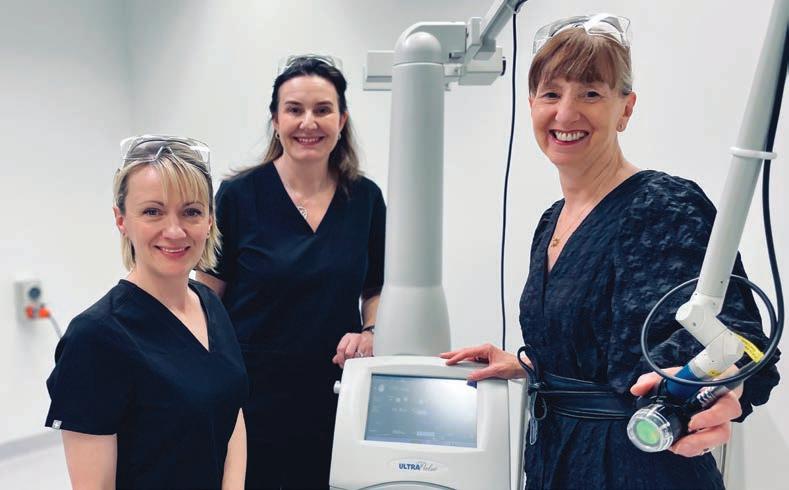
However, these adjuvant therapies are not without discomfort or the (however small) risk of malignant change. Many areas such as the sternum or face are much less easy to compress and far less suitable for radiotherapy.
In our experience, CO2 laser combined with immediate steroid injection provides excellent relief of itch and pain and improves scar thickness significantly. Most patients with keloids require 3-6 treatments for maximal effect (as opposed to hypertrophic scars, which usually require 1-3 treatments) but can get an excellent result with a single treatment as shown in Fig. 1 & 2.
The introduction of isotretinoin has improved the outcomes of many people who suffered with severe acne and reduced the burden of scarring. However, acne scars still occur and can cause significant distress.
Resurfacing full-field CO2 laser treatments for acne scars, though very effective, were historically limited to paler-skinned people due to very high rates of hypopigmentation caused by the 14 days it took for the skin to re-epithelialise. This prolonged period of raw skin was painful, and risks of infection and scarring were not insignificant.
Breast Cancer Trials research group has just opened a MRFF funded trial to test the drug olaparib’s effectiveness in preventing breast cancer recurring in young women, particularly those with hormone receptor-positive HER2-negative early breast cancers.
Researchers are looking at whether olaparib or in combination with durvalumab can disrupt the tumour’s DNA repair process. Olaparib kills tumour cells more efficiently when they are HRD-positive and may also increase the body’s immune response.
Durvalumab in combination with olaparib may enhance the body’s immune system to fight the cancer and researchers are keen to see if it will make the treatment more effective.
The OLIO study will be recruiting 50 participants primarily in Victoria and NSW.


‘Problem’ scars such as keloids, acne scars and harm scars can be significantly improved
CO2 laser is a game-changer in the treatment of problematic scars
Improving scarring can require a multi-modal approach, combining laser with surgery.
Modern fractional resurfacing CO2 lasers result in healing within 5-6 days, meaning tanned and darkerskinned individuals can safely have this treatment for scars as well (See Fig 3 & 4).
Harm scars are very common. In 2023, there were almost 25,000 hospital admissions in Australia for intentional self-harm, and it is estimated that only 10% of all cases are recorded. These injuries are


more frequent in younger people, however, older people often seek improvement of scars that were created when they were younger.
Awareness of the spectrum of mental health issues and the normalisation of seeking help for these conditions has improved dramatically over the past 10 years, though the stigma of harm scars or the reminder of a painful time in their life means that many people with harm scars would choose to improve them if they could.
If harm scars are still raised and/or red they can be reliably improved with CO2 laser which makes them flatter and paler.
Once flat and pale, cosmetic tattooing can match the colour of the surrounding skin and disguise these fine lines. Colour-match and pigment technology has improved significantly, and this can be an excellent solution once the scars are flat (raised scars won’t take tattoo
pigment; they require flattening with CO2 laser first)
Harm scars which are widened and/or numerous and linear, even when they are flat and the same colour as the surrounding skin, are still obvious as linear scars. These scars may be more appropriate for surgical revision to change the direction of scars to disguise the linear nature (using plastic surgical techniques like z-plasties) or in extreme cases, resurfacing the entire area with a skin graft.
In summary the treatment of scarring has progressed over the past 15 years, and we now have some answers to our ‘problem’ scars.
ED: The authors are all specialist plastic and burns surgeons
Author competing interests – nil

A lonely misfit and an eccentric older woman change each other’s lives in Adam Elliot’s latest clayography film Memoir of a Snail.
Inspired by people he knows and people he’s seen, Adam Elliot delivers Memoir of a Snail, a poignant, heartfelt and hilarious chronicle of the life of an outsider finding her confidence and silver linings among the clutter of everyday life.
This is the second clayography film by the Academy Award-winning animation auteur and the follow-up to the acclaimed Mary and Max
Meet Grace Pudel, a lonely misfit with an affinity for collecting ornamental snails and an intense love for books who is retelling her life story to a humble garden snail named Sylvia.
At a young age, Grace was separated from her fire-breathing twin brother Gilbert and spirals into anxiety and angst. Despite a continued series of hardships, inspiration and hope emerge
By Ara Jansen

when she strikes up an enduring friendship with an elderly eccentric woman named Pinky, who is full of grit and a lust for life.
“The protagonists in all my films are outsiders and my themes and
narratives explore difference,” says the Melbourne-based filmmaker. “I love telling stories that are infused with humour and pathos, reflections of our own everyday lives that celebrate the moments of joy with
the darkness that comes with life’s challenges. For over 30 years my objective has been simple: make my audiences laugh ... and make them cry.”
Once again, the movie is voiced by some of the world’s leading actors in Sarah Snook, Kodi Smit-McPhee, Eric Bana, Dominique Pinon and Jacki Weaver.
Shot in the traditional and timeconsuming artform of stop-motion animation, every single prop, set and character is a unique handmade tangible object made by a team of artists who spent almost a year making the 7,000 objects needed to tell Grace’s tale.
Hundreds of arms, eyeballs and mouths were handcrafted and then brought to life by stop-motion animators who spent thousands of hours in the dark moving each character a frame at a time. There is not a single frame of CGI and over a 33-week shoot. The cinematographer and camera team lit more than 200 sets and assisted the animators in capturing the 135,000 photographs needed to create the film.
Australian composer Elena KatsChernin composed the score, which was brought to life by the Australian Chamber Orchestra and the Cantillation choir, alongside soprano Jane Sheldon who sang Grace’s haunting theme.
Like previous adult works, the film is based on Adam’s family and friends and explores challenging subject matter that is often dark but tempered with moments of hilarity and warmth.
“I love adding quirks and idiosyncrasies to my characters’ psyches and try and give them incongruities and dimension; make them as empathetic, universal and real as possible. My stories are reflections of everyday life, biographies of people we can relate to, friends, eccentric relatives and the colourful people we encounter in the street.
“I try to get a balance between humour and pathos, light and shade, comedy and tragedy. I invented a word to describe my films – clayographies – a portmanteau term combining clay and biographies.”
As an auteur, Adam must wear many hats. One of his favourite roles is production designer. During
COVID lockdown in Melbourne, Adam spent his confinement prepping for the film. Over five months he hand-drew all 1600 storyboard panels on pieces of paper then moved on to drawing the 200 characters, 200 sets and the thousands of props that would be handmade. He wanted to keep the materials and aesthetic simple and use four basic materials – clay, wire, paper and paint.
“Too much stop-motion has become slick and reliant on 3D printers. I wanted to celebrate the clay, its lumps, bumps and imperfections. I was born with a hereditary shake which I have incorporated into my aesthetic. We had signs throughout the studio
that read Chunky Wonky. Every asset had to look flawed as if made in a hurry or by someone who was drunk.
“My characters’ psyches are imperfect, so I wanted their appearance to match my drawings which are loose, gestural and naive. I have a holistic approach to my work and strive for originality. Art imitates life and vice versa. For me they are inseparable and both art and filmmaking have become my yoga.”
Memoir of a Snail is in cinemas October 17.
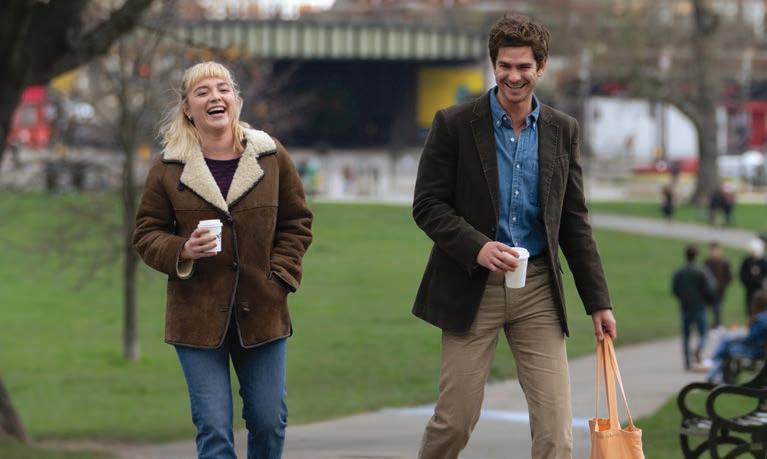
The British Film Festival returns to Perth from November 6 to December 8, with a stunning selection of films from the British Isles.
The line-up includes dramas, thrillers, comedy, documentaries and retrospectives, featuring many of Britain’s most admired acting and directing stars.
It includes the Australian premiere of the highly anticipated We Live in Time, with nuanced performances from Oscar nominees Florence Pugh and Andrew Garfield, delving into the question of how to make the most of the time we have.
Also screening is Widow Clicquot, based on the true story of BarbeNicole Ponsardin, the Grande Dame of Champagne, otherwise known as Veuve Clicquot. And the romance Four Letters of Love features a commanding cast including Pierce Brosnan and Helena Bonham Carter. The festival screens at Palace Cinemas Raine Square, Luna Leederville, Luna on SX and Windsor Cinema. Medical Forum readers have the chance to win one of five double passes. .
To enter, use the QR code on this page or go to mforum.com.au and hit the competitions tab.
In 1840, John Septimus Roe, Western Australia’s first Surveyor General was granted 4000 acres of riverbank land at West Swan. He named it Sandalford after a priory in his English home at Berkshire. The property became prosperous as an agrarian estate supporting crops, cattle, fruit and vegetables and vines for table grapes, sultanas, raisins, currants and wine grapes. Early varieties planted were Shiraz, Verdelho, Cabernet Sauvignon and Frontignac. Export markets were established by Roe’s grandson John Frederick Roe, who had taken a keen interest in the fertile soils of the Swan River
The estate survived the vicissitudes of the Great Depression and two world wars and in 1970 made its second acquisition of prime viticultural land. Influenced by Dr John Gladstones’ treatise on the suitability of the Margaret River region for premium wine production, and winemaker Dorham Mann, the Roe family purchased 300ha at Wilyabrup making them one of the early pioneers of the Margaret River vineyards. The next quantum change came in 1990 with the purchase of the estate by the Prendiville family headed by Peter and Debra Prendiville. The Prendivilles, who were experienced operators in tourism and hospitality, have taken Sandalford to the next level of quality wine production. Today, a comprehensive range of wine is produced –from the budget priced right up to the super premium Prendiville range. Senior winemaker Ross Pamment and vineyard manager Ben Maher head the production team.


From old Swan Valley vines and stainless steel fermented. No oak involved. Delightfully fresh, spring flowers and tropical fruit aromas. Full flavoured with a touch of ginger rounding out the finish. Perfect chilled on a summer’s day. (14% alcohol $33)
A lovely pale salmon colour. Fresh flowers and summer berries. Crisp, mouth-filling savouriness. Refreshingly dry finish. No wood contact. Drink chilled. (12.5% alcohol $33)
From 50-year-old Wilyabrup vines in a cool vintage. Cedary new oak. Soft cassis flavours and a hint of chocolate and olive. Fine grained tannins, some tautness leading to a full flavoured and long finish. This is classic Margaret River Bordeaux style cabernet that drinks well now at five years of age and will blossom further at 10 years. (14.5% alcohol $55)
Savoury spice and berries invoking memories of moist Christmas cake. Ripe and peppery with attractively integrated grape and French oak tannins. Generous depth of flavour from old Wilyabrup Shiraz vines. Drink now or keep for five more years. (15% alcohol $55)
This classic sherry variety thrives in the alluvial Swan Valley soil. The grapes are left to fully ripen and then fortified to 18 degrees alcohol. Ageing in cask for an average of 30 years results in a luscious mahogany coloured liqueur with nutty rancio sweetness, beautifully held in check by fine fortifying spirit. This is a classic wine style for which the Swan Valley is justly famous A fabulous sip at the end of a meal. Expensive maybe but 30 years of ageing is a rarity. (18% alcohol $130)
As good as the table wines were at the tasting the Sandalera Pedro Ximenez was a spectacular standout.







NEDLANDS
Rare Large Medical Suite on Hollywood Campus
•Huge 96sqm* medical suite
•Generous waiting and reception area
•2 huge consulting rooms
•Fully Fitted & Furnished Suite
•1 car bay on title
•Ready for occupation
•Central location within the specialist centre
•Modern fit out
•Exclusive basement storage area
Asking Price $984,000+ GST
Asking Rent $450/sqm + Outgoings + GST
Luke Randazzo 0417 181 309 lrandazzo@brwa.com.au
Rob Selid 0412 198 294 rselid@brwa.com.au

Lot 3 / 140 Mounts Bay Road, PERTH Mount Medical Centre - RARE OPPORTUNITY
MMJ Real Estate (WA) are pleased to present to market this rare opportunity to buy this 76sqm medical consulting suite located on the third floor within the Mount Medical Centre.
Key Features:
•Strata area of 76sqm
•Fully fitted with reception, meeting room and main consulting room
•Small storage area
•Kitchenette
•Corner position with good natural light
•Views towards Kings Park
•2 secure undercover car parking bays
This unit is situated within a prime location adjacent to the Mount Private Hospital one of Western Australia’s leading private providers of Cardiology and Cardiac Surgery.
For more details or to inspect contact Tom Prout on 0434 746 259 or tom.prout@mmj.com.au

Suite 39, HOLLYWOOD
MEDICAL CENTRE, Nedlands
•Furnished, generously proportioned Consulting room available for specialists.
•Currently available Tuesdays and Wednesdays on sessional basis.
•Half day or full day, depending on requirements.
•On second floor of the exclusive Hollywood Medical Centre.
•Corner suite with exceptional views, reception, waiting area and kitchenette.
•Onsite on Hollywood Private Hospital, with Cafe and all other amenities
•Dedicated undercover car bay available for parking
•Easy patient parking in multi-storey car park
•Admin/Secretarial support requirements can be discussed
A unique opportunity to have a prestigious practice location long term!
For more details or to view, contact Amit on 0451824144 or Email Admin@dramitsaha.com.au


ELLENBROOK
Medical & Consulting • Offices
56B Mornington Parkway, Ellenbrook, WA 6069
Price information
Lease: $25,000 excluding GST p.a.
Key property information
Floor area: 80 m2
Outgoings: $10,100 p.a.
Specialised Medical Unit
•Rare Medically Zoned Unit
•Previous Dental Use
•Available Immediately
Tilt Commercial is pleased to present this dedicated medical suite for lease in the rapidly expanding area of Ellenbrook. As one of only two units on site, this facility is not to be missed.
• 80 m2 medical unit
• Independent rear parking for staff
• Fit-out included if required
• Previously used for dentistry
• Adjoining orthodontist
• Part of the Mornington Medical strip
• Front parking and entry for clients
• Rear parking and entry for staff
• Available for immediate occupation
For further details, please contact Adam Yeo from Tilt Commercial, 0410 483 121

WEMBLEY
2 rooms available for lease
Consulting room 15m2
Consult/treatment room 23m2 (has sink, can be sub-divided)
Within Suite 2, 178 Cambridge Street, Ground floor
Undercover car bays available for staff parking
Opposite St John of God Hospital Subiaco
Radiology and pathology in same building
Physiotherapy available on site
Great patient parking
600m walk from Subiaco train station
Sessional basis considered
Specific fit-out requirements to be discussed
Admin support requirements can be discussed
·Suite facilities include new reception/ waiting room, kitchenette/break room, treatment rooms
For more details or to view, contact Johan on 6166 3751 or jm@thebonejoint.com.au

Earn 100% of Billings for the First 3 Months!
Join our well-established, accredited mixed-billing clinic in Burswood and earn 100% of billings for the first 3 months (75% thereafter).
Perfect for new VR GPs looking to establish themselves, with full-time/ part-time options.
Work alongside 3 experienced GPs in a fully computerized clinic with on-site pathology and RN support.
Please contact Dr Ang on 9472 9306 or Email: info@thewalkingp.com.au

Full time or Part-time VR GP
Private doctor-owned medical centre, providing excellent medical services to our patients for 35 years.
We offer:
•Excellent earning potential as a private billing Medical Centre
•Experienced administrationmanagement team
•Convenient proximity to the CBD
•Hourly retainer for the first few months while you settle in and build your own patient base
•Full-time doctors have exclusive use of their own room and part-time doctors would share with another part-time doctor.
Contact the Practice Manager, Claire Stocks, on 0422 511 906 or claires@ccmc.net.au

Queens Road Surgery is a busy GP owned general practice located in Mount Pleasant.
We are looking for a VR GP to join our well established practice.
We offer a supportive team based culture, experienced administrative staff and quality full time nursing support.
Queens Road Surgery is a fully equipped accredited practice.
For a confidential discussion please contact our Practice Manager Narelle 0412 113 584 or narelle@queensroadsurgery.com.au
9203 5222


























We respect your time is precious. Humphrey Homes’ integrated model of architecture, building and interior design ensures you realise your vision with unrivalled efficiency, construction quality and budget control. To learn how our approach makes the process seamless and enjoyable, contact Dean Humphrey for an informal chat





